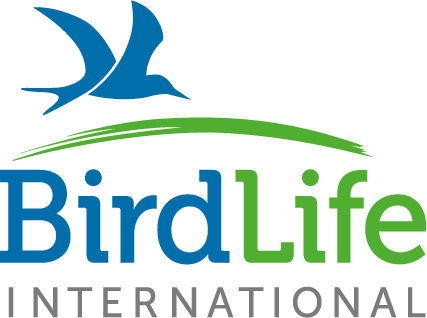1) Alrø
2) Blåvandshuk
3) Brabrand Sø & Årslev Engsø
4) Draved Skov and Kongens Mose
5) Fanø
6) Filsø
7) Frøslev Mose
8) Gammel Hviding Engsø
9) Mandø
10) Margrethe Kog
11) Nørrestrand
12) Oldenor and Mjels Sø
13) Pamhule Skov & Hindemade
14) Rømø
15) Skallingen, Langli & Ho Bugt
16) Skjern Å valley
17) Sneum Digesø
18) Stavns Fjord, Samsø
19) Sølsted Mose
20) Tinglev Mose
21) The Tipper Peninsula
22) Tøndermarsken
23) Velling Skov & Vrads Sande
24) Vænge Sø
Alrø
Island in Horsens Fjord, East Jutland
Breeding and staging waders
See Google map with car park etc.

Lapwing with young. Photo: Helge Sørensen
Description:
Alrø is an island in Horsens Fjord connected by an embankment to the north side of the fjord. Most of the island is cultivated, but just south of Alhale – the eastern peninsula – is an area (Pollerne) with sand flats that are exposed at low tide and are dotted with islets and boulders.
Birds:
Breeding birds:
Oystercatcher, ringed plover, lapwing and redshank are typical breeding birds. Meadow pipit and yellow wagtail can be seen on the coastal meadows, and mute swan, eider, red-breasted merganser, black-headed gull, common gull and arctic tern breed on the islets. Even though common tern and sandwich tern no longer breed on Alrø, they make their appearance here with their young in the summer months. Cormorants from the colony on the island of Vorsø, which lies north-west of Alrø, can be seen in the area at all times, especially on Pollerne. Heron also breed on Vorsø and forage in the neighbourhood.
Migrating and staging birds:
In spring and autumn, golden plover, lapwing, dunlin and bar-tailed godwit appear in large flocks. Other guests include ringed plover, grey plover and knot, and with luck one can spot little stint and curlew sandpiper. Waders can be seen on the sand flats (Pollerne) south of the peninsula of Alhale. It is not unusual to see snipe, spotted redshank, wood sandpiper and common sandpiper here. Curlews are nowadays seen nearly all year round, sometimes in flocks of more than 300.
Apart from waders it is possible to see great crested grebe, wigeon, teal, mallard and pintail. Greylag goose are numerous, especially in late summer. Brent geese stop over here on occasions. Large flocks of barnacle geese are seen on the island in the winter months. One can also be lucky enough to spot pink-footed geese and now and again white-fronted geese.
The pair of white-tailed eagles that nest on Vorsø are often seen foraging around Alrø. In winter, peregrine is a frequent guest, and marsh harrier passes by on migration.
In winter, the air is filled with the cries of whooper swans flying over the island, and there are sometimes large flocks of them on the fields. Mute swans and mallards congregate on the fjord. Diving ducks such as eider and goldeneye can be observed further out in the fjord and sometimes small flocks of twite and snow bunting fly along the coast and over the meadows.
Visiting and access:
From the town of Odder, south of Århus, take route 451 in a southerly direction. Just after Ørting, a minor road leads south to Alrø.
There is no access to the privately owned areas on the island and unfortunately a bird observation tower, that had stood here for many years, has now been removed. This means that birds can be watched only from the public roads. The best view over the the sand flats at Pollerne can be had just after the road has swung round to the right immediately after the embankment. One can also drive all the way out to the car park on the southernmost point of the island, or take one of the smaller roads going off to the north and south, from where other parts of the fjord can be viewed.
 Yellow wagtail. Photo: Helge Sørensen
Yellow wagtail. Photo: Helge Sørensen
Blåvandshuk
South-west Jutland, north-west of Esbjerg
Blåvandshuk is Jutland’s best locality for autumn migration
See Google map with car park etc.
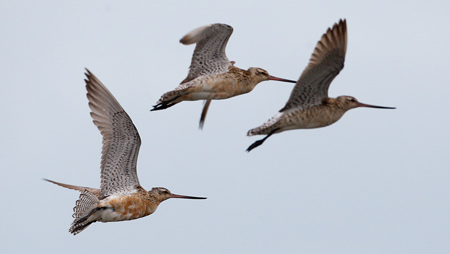
Bar-tailed godwits. Photo: Helge Sørensen
The coast at the hook of Blåvandshuk boasts one of Denmark’s largest sandy beaches – at some places it is several hundred metres wide. Behind the beach there are sand dunes and stunted pine trees. The scrub around the lighthouse sometimes gives shelter to many passerines, both night migrants and day migrants. Denmark’s longest reef – and also one of the most dangerous – Horns Rev, extends 40km out into the sea from the hook.
Migrating and staging birds:
Migration at Blåvandshuk comprises both seabird passage and passerine migration along the coast. Seabird movements can best be seen in strong westerly or south-westerly winds, whilst waders, raptors and passerines can best be seen in easterly winds.
Divers, fulmars, gannets, ducks, skuas, kittiwakes, common terns, arctic terns and sandwich terns can be seen over the sea. If the wind is strong to gale force from west/south-west, there is a good chance of seeing sooty shearwater and Manx shearwater and also Leach’s petrel, grey phalarope, Sabine’s gull and auks.
Wader migration begins in early summer. All species of wader can be seen. In July the adult waders pass by, and can be very numerous, especially on days with easterly winds. The waders often come in mixed flocks, but also flocks with single species such as oystercatcher and knot. Blåvandshuk can boast Europe’s largest migration of oystercatchers. Knot, dunlin, sanderling and bar-tailed godwit are seen in large numbers, and grey plover, curlew and turnstone are common. Curlew sandpiper appears in small numbers. A day with more than 20 migrating curlew sandpipers can be called a good day. On a really good day one can see up to 50 individuals migrate south in mixed flocks together with dunlin. Terns abound over the sea - and attract skuas. In September/October many ducks pass by the hook, especially common scoter, wigeon, teal and pintail. Easterly winds bring greylag goose, pink-footed goose, brent goose and barnacle goose.
A regular stream of passerines flies along the coast, including swallows, martins, meadow pipits, crows, chaffinches and thrushes. 2006 saw a new daily record for chaffinch/brambling with around 117,000 birds!
With some luck, a rarity such as Richard's pipit, red-flanked bluetail, Radde's warbler, dusky warbler, Pallas’s leaf warbler or yellow-browed warbler can be spotted. Blåvand usually comes up with a barred warbler or two in August and perhaps a greenish warbler with a little more luck.
Throughout October there is the possibility of experiencing days with really large numbers of thrushes, especially redwings, in the area of Ho and Nyeng. Numbers of 15,000 - 20,000 staging redwings have been noted - although at intervals of several years.
Blåvandshuk can be reached on route 431 from Varde via Oksby. There is a large car park where the road stops just before the beach.
Just before the car park is Blåvand Nature Centre, which contains a nature exhibition, a nature school, and one of the Danish Ornithological Society’s bird stations, where observations and ringing have been carried out for many years.

Arctic skua. Photo: Helge Sørensen
Brabrand Sø and Årslev Engsø
East Jutland, just west of Aarhus
The two lakes and the surrounding areas are important breeding areas for waterbirds and staging localities for many migrating birds during spring and autumn. Many birds spend winter on and around the lakes.
See Google map with bird observation towers, car parks, etc.
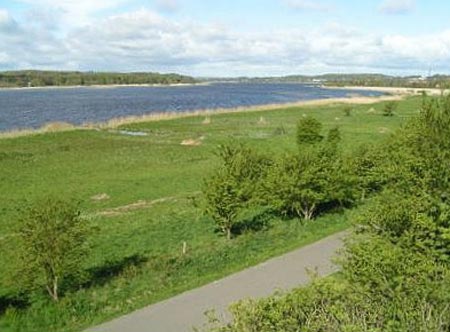
Brabrand Sø. Photo: Anders Horsten
The two lakes, Brabrand Sø and Årslev Engsø, lie in a sub-glacial trench valley formed during the ice age and are joined together by the river of Aarhus Å. Årslev Engsø, that used to be a drained area, was re-established in 2003 by directing the water from the two rivers Aarhus Å and Lyngbygård Å over its meadows. The lake itself now covers an area of 100ha (max. depth 2m). It is surrounded by meadows and reedbeds, that will probably spread in the coming years. Brabrand Sø (153ha – max. depth 2.7m) is surrounded by reedbeds and wet meadows. In summer, parts of the lake are covered by waterlilies and common club-rush. Several of the meadows are grazed in summer by cattle and horses.
Brabrand Sø is under preservation orders, but some hunting takes place on the privately owned land near the lakes, and there is a fair amount of fishing along the rivers that run into the lakes.
Breeding birds:
The birdlife in Brabrand Sø is typical for a shallow, nutrient-rich lake. Characteristic birds are great crested grebe, greylag goose, tufted duck, pochard and grey heron. Black-necked grebes breed here with up to 5 pairs. The last few years, bittern has been heard booming regularly in springtime at several locations in the reedbeds, both at Brabrand Sø and Årslev Engsø. Two pairs of marsh harrier breed regularly, and here and there one can find breeding bearded tit. Several pairs of bluethroat nest at Årslev Engsø. Kingfisher is often seen in the breeding season.
During migration, many bird species use the area as a stop-over. Nearly all dabbling ducks can be seen, both spring and autumn. The meadows attract many waders such as common sandpiper, green sandpiper, greenshank, spotted redshank, lapwing, snipe, jack snipe and ruff. The many wood sandpipers and Temminck’s stints are especially interesting. In autumn, greylag geese forage on the meadows, that are also visited by goldfinches and starlings, the latter often in large flocks. Many mute swans turn up in autumn and spend the winter on the lakes together with flocks of goosander. Whooper swans also arrive at the end of autumn and are regular winter guests.
Many passerines stop over in the area during migration, for example reed warbler, marsh warbler, sedge warbler, grasshopper warbler, linnet, dunnock, yellow wagtail, red-backed shrike, siskin and reed bunting. They can be seen in the reedbeds and the scrub and in the small woods in the area.
Årslev Engsø attracts many uncommon birds that turn up regularly, for example osprey, white-tailed eagle, peregrine, little gull, Mediterranean gull, black tern, Caspian tern, spotted crake, broad-billed sandpiper, red-necked phalarope, water pipit and great reed warbler. On very few occasions, little egret, great white egret, corncrake, great snipe and white-winged black tern have been seen. Some very rare species have also been spotted: in later years, for example, green-winged teal (2012), brown shrike (2012), ferruginous duck (2013), marsh sandpiper (2022) and redrumped swallow (2022).
3. At the scout hut at Bispevej in Stavtrup Søholm, south of Brabrand Sø, from where there is access to a bird observation tower.
4. On the south side of Storskovvej, south of Årslev Engsø and west of the estate of Constantinsborg. From here one can reach the path on the southern bank of Årslev Engsø where there are two bird observation towers.
5. At Skibbyvej north of Årslev Engsø there are two car parks - one close to Skibby and one a little further north. There is also a bird observation tower on the north side of Årslev Engsø.
The lakes can also be reached by bus from the centre of Aarhus, for example no. 11 to "Stavtrup Søholm", that has its terminus next to a little wood on the south side of Brabrand Sø, where there is a path to the observation tower.
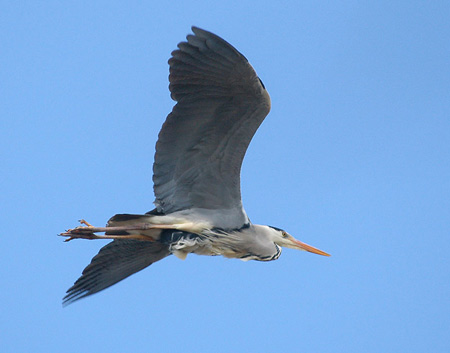
Draved Skov and Kongens Mose
A few kilometers south of Løgumkloster
An old forest with several species of woodpecker
See Google map with carparks, observation towers, etc.
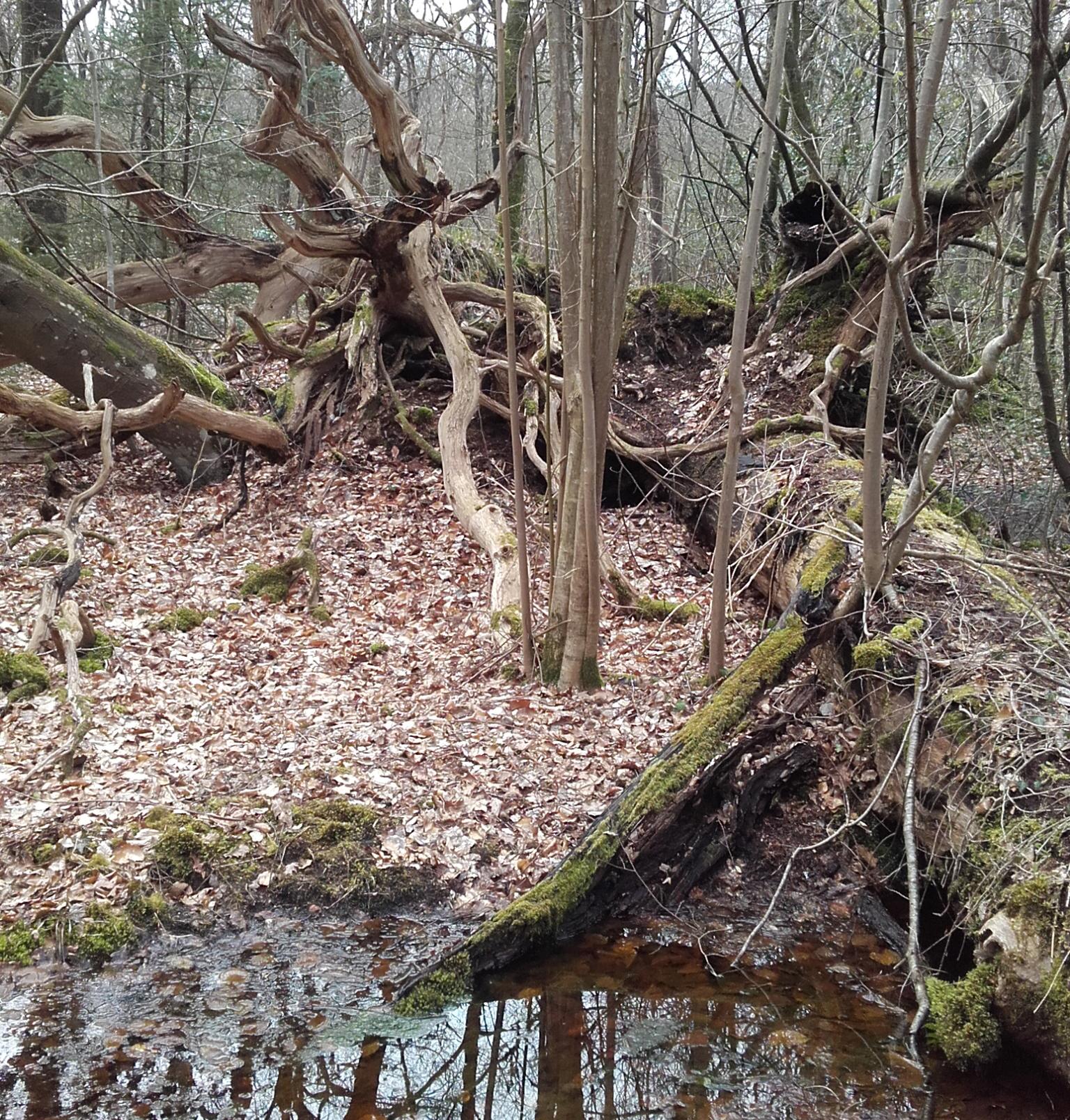
Draved Skov in April. Photo: Joy Klein
Description:
The forest of Draved Skov and the adjoining bog of Kongens Mose, which are state-owned, each cover around 250 ha, giving a natural area of 500 ha in total.
In Draved Skov, most of the trees which grow naturally in Denmark can be found, first and foremost small-leaved lime, which was the dominant species in Denmark’s original virgin forest, but which has now more or less disappeared from the rest of the country. In addition, common alder, oak, beech, ash, birch, rowan, wild apple, hazel, holly, hawthorn and alder buckthorn are found here. Large areas in the forest were put under conservation orders in 1920 and as from 2000 it has been a minimum-intervention forest. Areas with old trees and dead timber attract fungi, insects and birds. Over 160 different bird species have been registered in Draved Skov, making it one of Denmark’s most species-rich bird localities.
West of Draved Skov is Kongens Mose, which is one of Denmark’s largest raised bogs. Formerly it was drained and used for peat excavation, but is now under conservation orders and drainage has been stopped. Large areas are now under water and the peat moss has begun to grow again.
There are now plans for creating a so-called “Nature national park” covering the whole area.
Birds:
Draved Skov is well known for its woodpeckers – four species can be found here: green woodpecker, black woodpecker, great spotted woodpecker and lesser spotted woodpecker. In addition, middle spotted woodpecker has been observed in February-April the last few years. The best time to spot the woodpeckers is in early spring, when they are very active, and when the trees are still bare of foliage. Due to the dead trees, other hole-nesting birds can be found, including stock dove, tawny owl and nuthatch. The forest also houses both treecreeper and short-toed treecreeper, together with a wealth of more common passerines such as tree pipit, robin, redstart, song thrush, mistle thrush, tits (including willow tit), bullfinch and hawfinch. Raven breeds in the forest, together with buzzard, sparrowhawk and honey buzzard. Goshawk is seen now and again.
Kongens Mose is home to cranes practically all year round and two to three pairs breed here. Quail can be heard in the bog. The area also attracts bluethroat, whinchat and stonechat. Red-backed shrike breed here in summer and great grey shrike appear in winter. In winter the bog is also a night roost for hen harrier. From time to time, white-tailed eagle and red kite can be spotted.
From the town of Løgumkloster follow the signs to Tønder. The road leads through Draved Skov and around half-way through the forest a car park can be seen on the right-hand side. The carpark has information boards and picnic tables. From here, a network of paths leads through the forest on both sides of the tarmac road.
It is a good idea to use the Nature Agency’s map of the area.
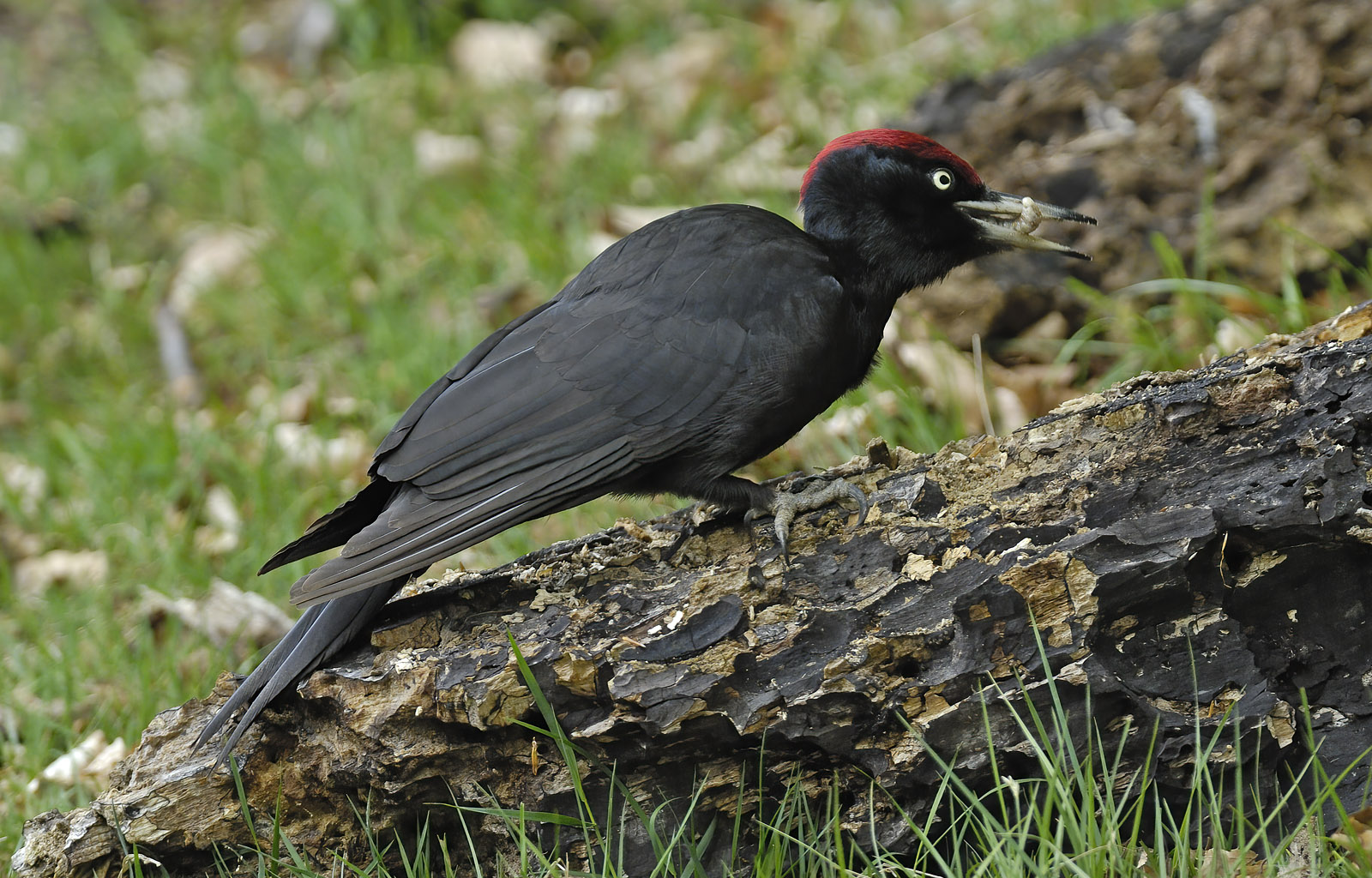
Black woodpecker. Photo: John Larsen
Fanø
South-west Jutland, in the Wadden Sea off the coast south of Esbjerg
Fanø is an important staging area for waders on migration, especially in autumn. Many birds fly over the island on migration. Breeding birds include bittern and nightjar.
See Google map

Snow buntings over Fanø. Photo: Kim Fischer
Fanø is the northernmost of the three inhabited Danish islands in the Wadden Sea. Many different kinds of scenery are represented here: sandy beaches, dunes, coastal meadows, heath and plantations. Around Sønderho on the island’s southernmost point are the three sandflats Keld Sand, Peter Meyers Sand and Langejord, where tens of thousands of waders roost at high tide. Along the east coast and in the northern part of the island are coastal meadows, and the west coast is dominated by expanses of sandy beach and dunes. The road joining the north and south of the island leads through extensive heaths and the plantation in the middle of the island.
Breeding birds:
Fanø is a breeding site for curlews and for the commonest waders such as lapwing, redshank, oystercatcher and snipe. A little population of the rare Kentish plover nests on Grønningen in the northern part of the island. Arctic tern and litle tern nest primarily on the remote sand banks south of Fanø.
Little grebe and red-necked grebe breed in the lakes south of Rindby and in the hollows in the dunes. In the reedbeds there are many bittern, but also marsh harrier and bearded tit. Bittern are often seen flying over the reedbeds in May/June. The dunes are home to stock doves, that build their nests in the old bunkers from world war two and in rabbit holes. The plantation houses a large population of nightjar.
Migrating and staging birds:
During migration, large flocks of waterbirds use Fanø as a stop-over site. Denmark's largest flocks of oystercatcher, grey plover, ringed plover, sanderling, knot and curlew forage in large numbers in the shallow waters round the coasts. Fanø’s southernmost point at Hønen is a good place from which to watch migrating passerines and raptors in autumn. Thrushes, pipits and finches pass by in especially large numbers. Days on which over 100,000 migrating birds are seen occur regularly and the largest flocks of ring ouzels in the country migrate from here.
In winter up to 1,000 snow bunting can be spotted on the beach. If there are strong winds from the west, tons of mussels are washed up onto the beach and attract tens of thousands of gulls.
The Fanø ferry sails regularly from Esbjerg harbour to Nordby on Fanø (three times an hour in the summer months). The crossing takes 10-15 minutes. It is possible to bring a bicycle or a car. Most of the island is accessible apart from the sand flats in the south east, Keld Sand and Trinden, where access is prohibited. Motor transport is forbidden on many roads through the woods and minor roads. The busiest roads have cycle lanes and there are bicycles for hire in Nordby, Rindby and Sønderho.
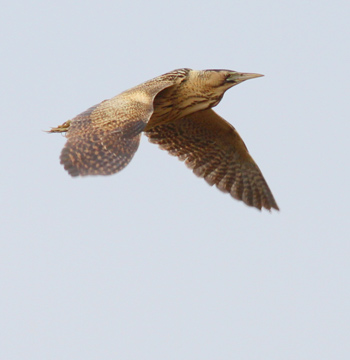
Bittern. Photo: Kim Fischer
Filsø
South west Jutland, north of Varde
A re-established lake and natural area that attracts large flocks of swans, geese, ducks and waders and many interesting passerines
See Google map with bird observation towers, look-out points, car parks, etc.
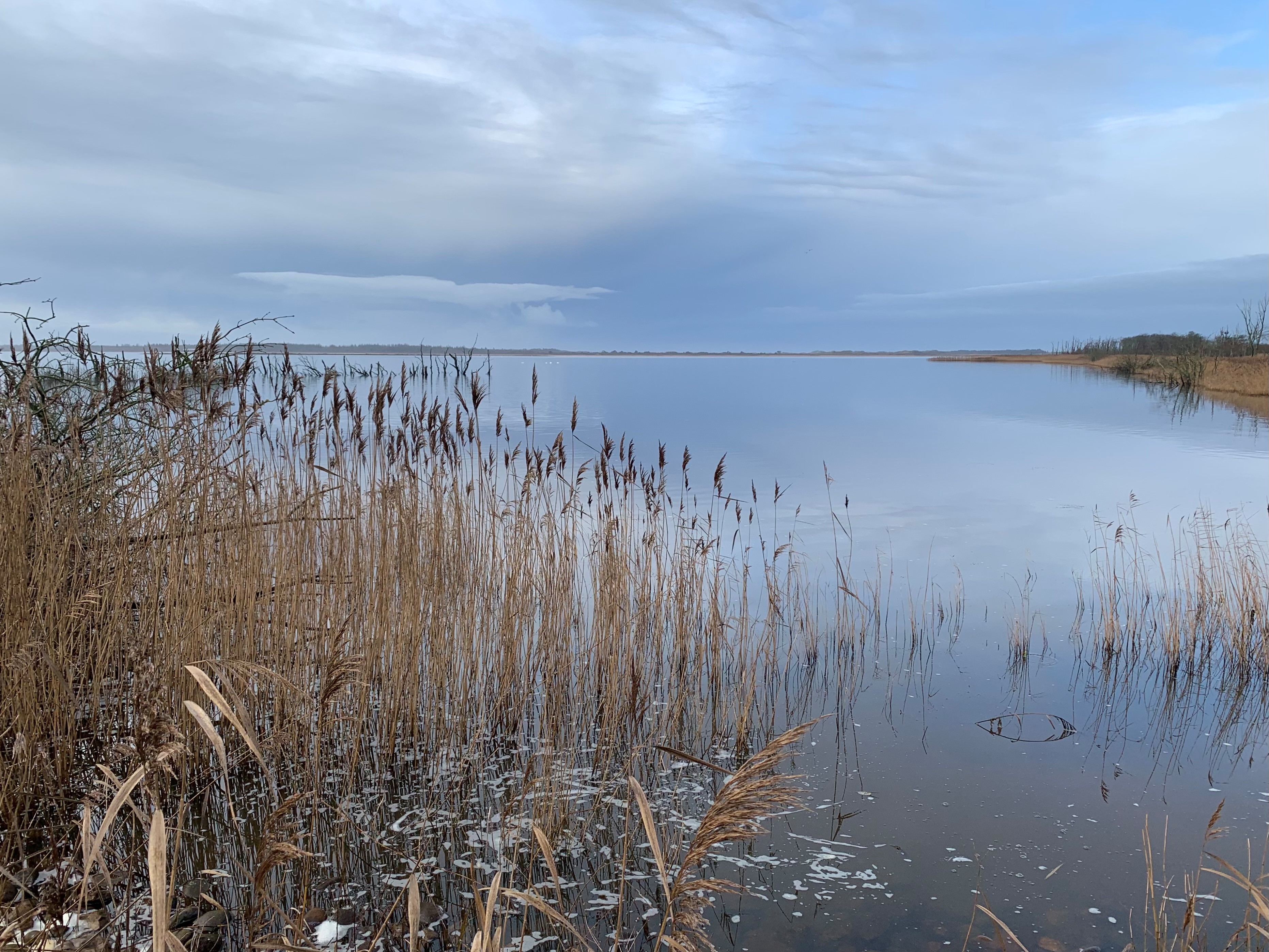
Filsø. Photo: Karin Gustausen
Description:
Filsø covers an area of 2308 ha near the west coast of Jutland between Ringkøbing Fjord and the Wadden Sea. In the stone age, Filsø was a large fjord or bay, until it became cut off from the sea by a spit. The lake gradually became a freshwater lake and the water level rose. It finally covered an area of around 3000 ha, thus becoming Denmark’s second largest lake. But it was shallow, and when ideas about land reclamation became popular in the 1800s it was an obvious choice for carrying out a drainage project. Drainage of Filsø began in 1852, when the waterlevel was lowered by 3m. This meant that most of the lake bed became pastureland, which was harvested for hay. In 1941-51, Filsø was drained even more and the lake bed could be intensively cultivated. In 1990 a pig farm was established on Langodde. But the land subsided and cultivation was no longer profitable.
In 2010, Filsø was taken over by Aage V. Jensen Naturfond, and a re-establishment project was begun. The embankments and buildings were removed and the pump stations stopped. Water began to seep in in 2012 and formed two shallow lakes: Søndersø and Mellemsø, together covering over 900 ha and crossed by an embankment called Dæmningsvej. Filsø is Denmark’s largest re-established lake. The new Filsø is 2-3 m deep in the southern section (Søndersø) south of Dæmningsvejen, and 1-2 m deep in the northern section (Mellemsø). It has the greatest variety of water plants in Denmark, with 52 species having been recorded so far. 14 small islands and islets have been established for the birdlife. The lake is surrounded by meadows, bogs and reedbeds. The fields on Petersholm and on the eastern side of the lake have been left to enable geese and deer to feed here.
Birds:
Filsø is situated on the flyway for several hundred thousand migrating birds and has become an important stop-over spot for geese, ducks, swans and golden plover. Several islets have been established, which attract many breeding birds.
Breeding birds:
A few pairs of little grebe and great crested grebe breed here. Mute swan, greylag goose, wigeon, teal, mallard, gadwall, shoveler and tufted duck also breed. Bittern can be heard in the reedbeds. Breeding waders include little ringed plover, lapwing, snipe and redshank. Several colonies of black-headed gull have been established on some of the islets around the lake, where common gull, herring gull, lesser black-backed gull, black-backed gull and common tern also breed. Mediterranean gull is another breeding bird. Just after the lake had been re-established gull-billed tern bred here, but only once (2013). A cormorant colony formed on the island of Aages Holm and now up to 1000 pairs breed on Storeholm and Under Holmbanken. The reedbeds house typical species such as water rail, sedge warbler, marsh warbler, reed warbler and bearded tit. The many passerines that breed in the area include bluethroat (around 25 pairs), whinchat, stonechat, willow tit and reed bunting. Several pairs of red-backed shrike can be seen in the area. 2-3 pairs of crane breed here and can be seen throughout the year. Kingfisher is another breeding species that can be seen all year round.
Last but not least, a pair of white-tailed eagles turned up after the lake was re-established and now breed in the vicinity every year.
Migrating and staging birds:
Flocks of whooper swan, Bewick’s swan, barnacle goose, greylag goose, white-fronted goose, golden plover and many ducks stage on the lake and on the meadows for long periods. Formerly, the area was an important stop-over site for the population of pink-footed geese that breed on Svalbard and used the cornfields for foraging. As the fields no longer exist the geese now only turn up sporadically and in smaller flocks.
Apart from the more common raptors such as sparrowhawk, buzzard and kestrel, osprey can be seen on migration, marsh harrier in the summer months and hen harrier in winter. Peregrine falcon is seen regularly throughout the year.
The area also attracts rarities. In 2014 slender-billed gull was seen here for the first time in Denmark. Since then, even more rarities have turned up including golden oriole, great reed warbler, cattle egret, red-necked phalarope, Mediterranean gull and Caspian tern.
Other animals:
The area houses a large population of red deer. Large flocks can often be spotted from the Petersholm observation tower. Otter is also often seen in the lakes.
Visiting and access:
Filsø is situated to the east of a minor road connecting route 465 in the north (the road to Henne Strand) and route 431 in the south (the main road between Oksbøl and Blåvand). The southern stretch of the road is called Kærgårdvej and the northern stretch Porsmosevej. Filsø can be accessed from the roads west and north of the area.
It is a good idea to download Aage V. Jensen Naturfond’s folder about the area, showing the paths, hides, and other facilities in the area. This can be found on Aage V. Jensen Naturfond's website about Filsø. For bird-watching the following possibilities can be recommended:
1. By driving north along Kærgårdvej one reaches a car park at Kærgård Plantage. Here are toilets, a barbecue site and an information pavilion. From the car park, a disabled-friendly path leads to Petersholm, where there is a large bird observation tower with access for wheelchairs. From here there is a good view over Petersholm and Søndersø.
2. The main entrance to Filsø is situated on the eastern side of Porsmosevej/Kærgårdsvej. The address is Filsø Ellipsen, Kærgårdvej 14b, Henne. Here there is a new and disabled-friendly visitor centre with a large car park, a circular outlook jetty (called the Filsø Ellipse) that goes out into the lake, toilets and picnic facilities.
3. From the visitor centre an embankment called Dæmningsvejen cuts across the lake. It is 3 km long and one can walk or cycle along it. From the road there is a fine view of both Søndersø and Mellemsø, and there is also access to the observation tower at Langodde with a view across Mellemsø.
4. It is also possible to follow a path going north from the visitor centre to reach the observation tower at Storeholm with a view across to the islands of Gåseholm and Storeholm.
5. Even further north is a small car park at Tejnebjerg on Porsmosevej. From here one can follow a path south to the bird observation tower at Storeholm and if desired, continue to the visitor centre. From the same car park one can also reach a path that follows the stream of Henne Mølleå to Kirkebyvad, where there is a pump station converted to an observation tower with a view across Mellemsø. One can continue even further eastwards along this path to reach the south-western corner of Fidde Sø, where there is a little outlook tower.
6. At Henne church, on Strandvejen, where one can park, there is a farm track going south, where one can walk or cycle. (The track starts opposite the boundary between the church and the inn). After around 1½km one reaches the pump station at Kirkebyvad.
7. There is a small car park on the eastern side of Filsø. The address is Filsøvej 30, 6854 Henne. From here there is access to Dæmningsvejen and the tower at Langodde.
To enjoy the view over the lakes, one can use the car park at Kløvbakken (Strandvejen, route 465) where there are a toilet and picnic facilities, or climb up onto the high dune of Tejnebjerg on Porsmosevej.
There is access to Filsø from 6 a.m. until sunset and one may walk around on foot, or cycle where it is permitted. There is no access to cultivated or fenced-in areas.
It is possible to rent rooms at Filsøgård. The website can be downloaded here.
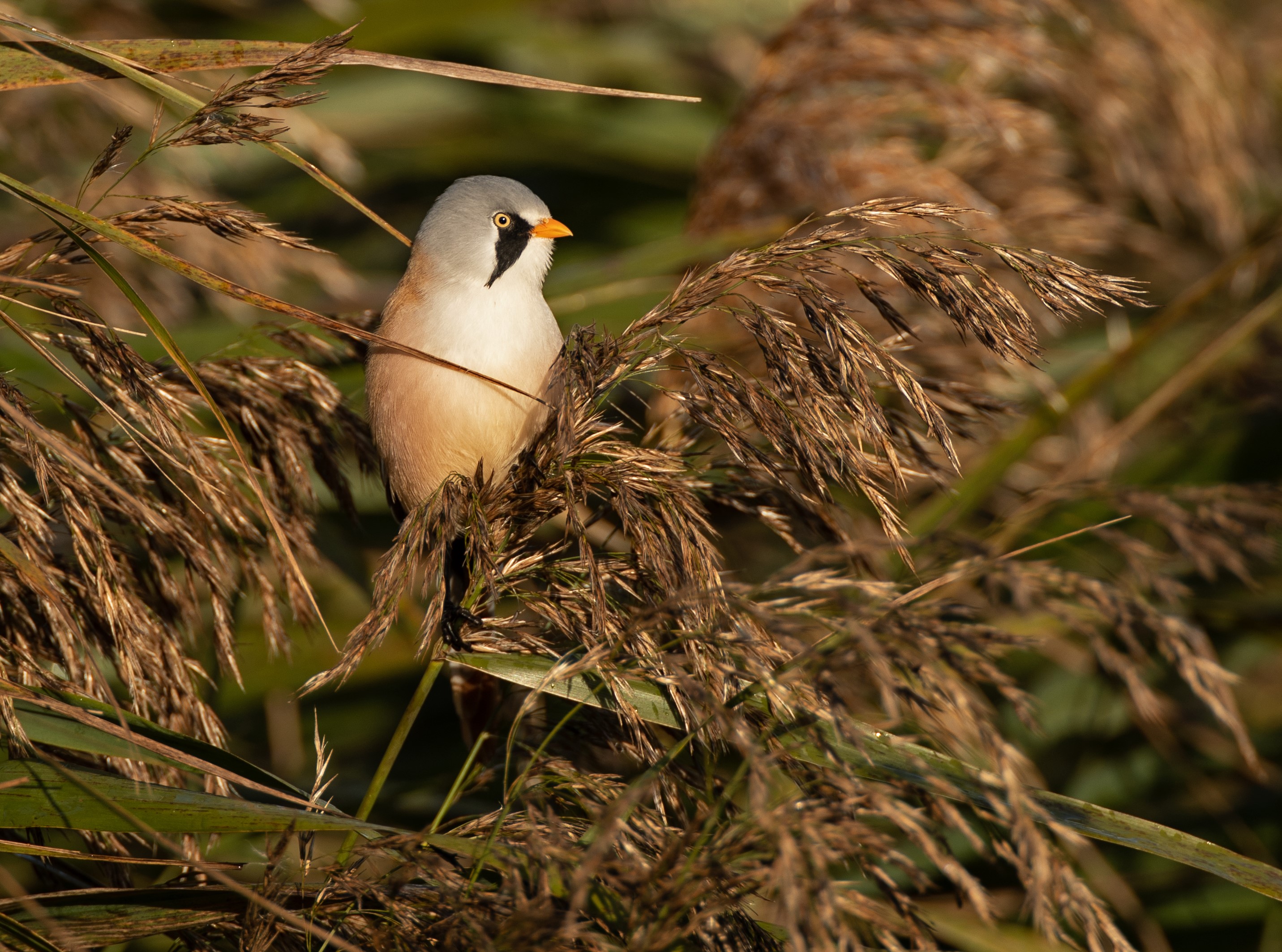
Bearded tit. Photo: Karin Gustausen
Frøslev Mose and Plantage
Southern Jutland
A rich birdlife in summer with many different species breeding in the bog and conifer forest
See Google map with car-parks etc.

Kådnermose in Frøslev Plantage
Description
Frøslev Mose is west of Padborg next to the Danish-German border. It continues across the border as Jardelund Mose. Both bogs together cover an area of 275 ha. Frøslev Mose is part of a large natural area of around 500 ha which also comprises the surrounding meadowland. The bog was formed on the heath which appeared after the last ice age. It was used for peat digging in the 19th century and up to just after the second world war. After this, the bog became overgrown. In 1985 it was put under preservation orders with the aim of restoring it to its former condition as a blanket bog. Today the water level is stabilized and the area is grazed by cattle.
In 2020 the Danish Nature Agency established sixteen new small ponds in the bog to attract insects and, in time, breeding waterbirds. Lapwing have already been spotted at the ponds and whooper and Bewick's swans have used the ponds to bathe in.
Connected to the bog is the plantation of Frøslev Plantage which is the southernmost forest in Jutland. It was originally planted between 1883 and the 1930’s on an area that had suffered from sand drift. The plantation covers 1041 ha and comprises mostly conifers, but there are also some old oak trees and other deciduous trees that have been planted more recently. Spread around in the plantation are some open areas with sandy heath and unusual formations called “klimper” which are sand dunes with small ponds on top. During the storms that have occurred during the last few years around 1/5 of the spruce trees have been blown down, resulting in many more new clearings. The Nature Agency now plant a greater variety of trees in the clearings, with more oak and beech than previously.
Birds:
The area has for many years been known as the first locality where new bird species that are spreading northwards have been spotted in Denmark.
Breeding birds:
Waterfowl include greylag goose, mallard, water rail and coot. After the new ponds were established, the number of breeding lapwing increaed to 3-4 pairs (formerly only 1-2 pairs). A pair of curlew breed, but in the German section of the bog (Jardelund Mose). The most characteristic wader is snipe, with 15-20 breeding pairs. During the last few years, cranes have begun to nest in the bog with 1-2 pairs. They can be seen throughout the year, presumably due to higher average temperatures.
The commonest passerines in the area are skylark, meadow pipit, whinchat, whitethroat, yellowhammer and reed bunting. Stonechat was found breeding for the first time in Denmark in Frøslev Mose in 1942 and now around 8-10 pairs breed each year. In addition, woodlark, grasshopper warbler and red-backed shrike can be seen. Bluethroat have spread to Frøslev Mose from the wetlands in the west of southern Jutland and 8-10 pairs now breed here. 2-3 pairs of willow tits breed at the edge of the bog.
In the plantation a number of birds typical for conifer forests can be spotted, for example goldcrest, crested tit, coal tit and crossbill. Nightjar has again started breeding in the plantation after an absence of 25 years. 4-5 birds can be heard churring in the south west section of the plantation around sunset in mid-June. Wryneck, which previously has been very rare in the region, was heard on four different locations in the plantation in 2020. To try and attract the species, 15 wryneck nesting boxes have now been put up. Black woodpecker can be spotted in the plantation but is best seen and heard from Pluskærvej and around 500m west of the motorway. Green woodpecker breeds now and again.
Frøslev Plantage was formerly Denmark’s best locality for turtle doves, with up to 17 pairs. It built its nest in 15-20 m high spruce. Its distinctive soft purring song, which resembles distant road traffic, could be heard from 1st May in the north western section of the plantation. In 2020 the population fell to 2-3 pairs for unknown reasons, and since 2021 it has stopped breeding in the plantation.
Two pairs of eagle owl have been breeding in the plantation for several years but since 2014 only one pair has been present. It has used the same nesting site directly on the ground hidden by a large larch tree. In 2015 the pair fledged two young.
Other bird species to breed regularly are goshawk, sparrowhawk, buzzard, honey buzzard, stock dove, tawny oil, long-eared owl and raven. Passerines include redstart, mistlethrush, firecrest and redpoll.
In the east of the plantation close to the motorway are the two small bogs Bredsig Mose and Kådnermose, where there are breeding greylag geese, mallards, moorhens and coots.
Migrating and staging birds:
Apart from the birds that breed here, the bog is a good site for many foraging species, especially the raptors that breed in the wood. Every year in the breeding season, Montagu’s harrier can be seen hunting over the bog. The birds are most probably from the German population. Marsh harrier can be seen here every year in spring and summer.
In winter there is a chance of seeing hen harrier, short-eared owl and great grey shrike.
Visiting and access:
Frøslev Mose can be reached from Pluskærvej, west of the southern motorway exit 76 at Padborg. Around 1½km west of the exit, turn left along Kristiansmindevej and then immediately afterwards right along Ladevej, which leads to a car-park with an information board. A 3.5 km long marked trail passes through part of the bog. Waterproof footwear is essential.
To reach Frøslev Plantation, one can also follow Pluskærvej, but park at a car-park around ½km west of the motorway exit. From here a “red trail” around 2km long goes through the plantation. One can also follow Lejrvejen, which leads out of the north of Padborg and crosses the motorway at the northern exit 76. On this stretch of the road there are several car-parks and access to a “yellow trail” around 5km in length that leads through the northern part of the plantation.
The Nature Agency has published a folder about Frøslev Plantage with a useful map, which can be downloaded here.
Other sights:
In the north-eastern corner of Frøslev Plantage is the Frøslev Camp Museum, which has been established in huts where members of the Danish resistance movement were imprisoned by the Germans in 1944-45.

Wryneck. Photo: Helge Sørensen
Gammel Hviding Engsø
South-west Jutland, south of Ribe
A newly established lake in the marshland, with various breeding birds and occasionally unusual visitors. View over the foreland with geese and waders.
See Google map with car park etc.
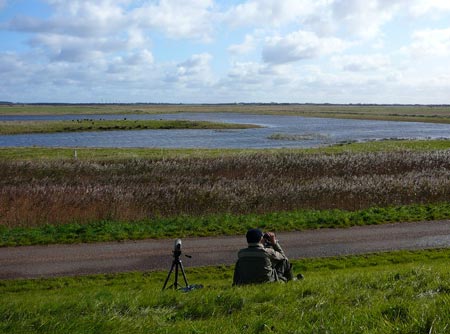
Description:
Gammel Hviding Engsø is south of Ribe and just east of the Rejsby seawall bordering the Wadden Sea. The lake was established in 2007 and is state-owned. The clay dug out here was used for strengthening the seawall, and the area was afterwards made into a bird-friendly lake, with a winding coastline and three islets. The area covers 28ha, of which 16ha are under water, the remainder being low-lying grassland. West of the seawall is the flat grass-covered foreland and the Wadden Sea.
Birds:
Breeding birds:
There are small numbers of breeding oystercatcher, lapwing and redshank, and a few pairs of ringed plover. In addition, there are a few pairs of great crested grebe, mute swan, mallard and coot. Bittern can be heard booming in the reedbeds, where sedge warblers and bluethroat (cyanecula race) can be spotted. The former colonies of gulls, terns and avocets on the islets have unfortunately disappeared due to overgrowth and - most probably - predation by raccoon dog.
Migrating and staging birds:
As early as February, large flocks of staging shelducks gather out on the foreland. In spring, barnacle geese and dark-bellied brent geese arrive. Waders such as golden plover, curlew and greenshank turn up on spring migration. On the meadows, ruff and yellow wagtail can be seen. Wigeon, gadwall, teal, pintail, garganey, shoveler and tufted duck can be seen on the lake. Cormorant feed here and now and again a kingfisher can be spotted. Cranes are often seen on the foreland and on the fields east of the lake. The lake can attract some interesting guests: spoonbill, little gull, black tern and white-winged black tern have all been spotted here. Great white egret can be seen throughout the year and little egret turns up now and again, even in winter.
White-tailed eagle and peregrine are regular visitors. Merlin can be spotted during migration, and in summer Montagu’s harrier can sometimes be seen flying over the reedbeds. Marsh harrier breeds in the vicinity and often hunts here in the summer months.
In autum, the geese come back again, and in winter flocks of shore larks and lapland buntings forage on the grassy areas, whilst smew, goosander and little grebe can be spotted on the lake. Short-eared owl visit the area around the lake now and again.
Other animals:
Otter is seen regularly in the lake (1- 2 times a month).
Visiting and access:
Gammel Hviding Engsø can be reached from route 11 (Ribevej) between Ribe and Skærbæk. About halfway between Hviding and Rejsby, Høgsbrovej turns off westward and becomes Gl. Hvidingvej, leading to the village of Gammel Hviding. From here, one can follow Gl. Hvidingvej westwards. Just after Hviding Nr. Rampe, the road turns sharply left and is now called Hviding Sdr. Rampe. After a right-hand bend one reaches the seawall, where it is possible to park. One can either walk south along the road inside the seawall or continue in the car. From the road there is a good view over the lake, but by climbing up onto the seawall one gets an even better view, and from here one can also see the grassy foreland and part of the Wadden Sea.

Mandø
South-west Jutland, in the Wadden Sea south-west of Ribe
There are birds everywhere on Mandø – both on the forelands and inside the dykes. The island is a paradise for birdwatchers, especially in the breeding and migrating seasons, when many geese, ducks and waders stage on and around the island.
See Google map
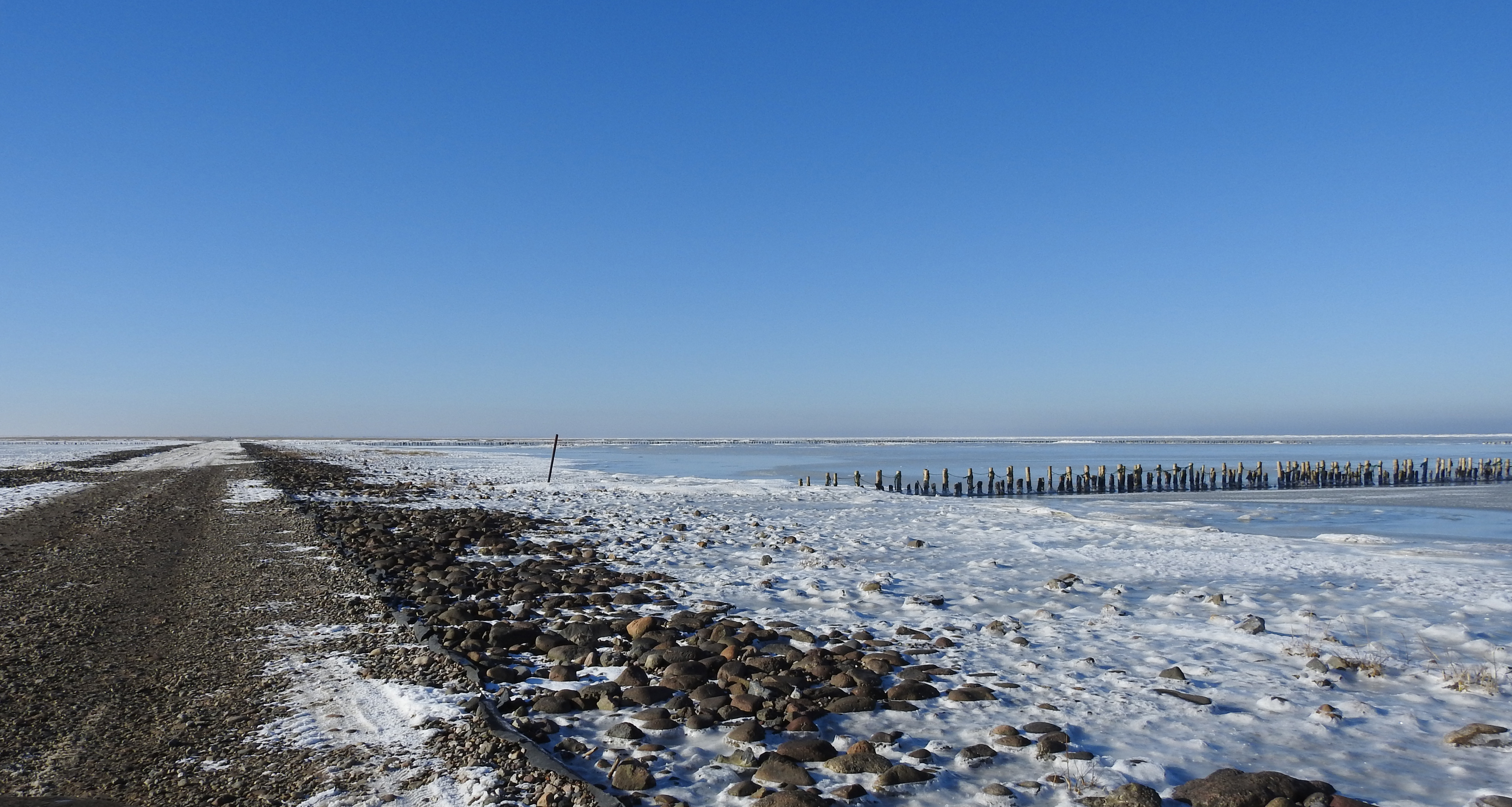
Mandø. The causeway, February 2021. Photo: Niels Knudsen
Description:
Mandø is situated in the Wadden Sea between the islands of Fanø and Rømø. The island can be reached by a causeway (Låningsvejen) which is flooded by the high tide twice a day. It is therefore important to check the high tide tables before planning a visit.
To the south-west of Mandø is Koresand, which is a high sandbank with an area twice the size of Mandø. Koresand is flooded at extreme high tides and there is no vegetation. There are very few breeding birds - primarily arctic tern and little tern.
Dykes have protected the island from storm tides for centuries, the latest addition being a seawall constructed in 1938. In front of the seawall, on the seaward side, is the foreland, with a network of fascines to encourage land reclamation.
Inside the seawall and parallel to it is a canal with a series of clay pits that were left after construction of the seawall. A road follows the canal round the island. Most of the embanked area on the island is extensively cultivated arable land. The village of Mandø is on the west side of the island, behind a protective line of sand dunes. This is the highest point on the island. In 1890, 262 people were living on Mandø – today there are only 32. There are only a few holiday cottages and tourism is limited because of the rather difficult access conditions. This means that Mandø is often a very peaceful place to walk around in.
In 2010 the Danish state purchased an area of coastal meadow covering around 50 ha on the north-eastern section of the island. Since then, the area has not been cultivated and hunting has come to an end. Drainage was stopped and a wetter environment was created to help the meadow birds. This has had an appreciably positive influence on the birdlife concentration. One of the many visible results is an avocet colony comprising 50-70 pairs.
Mandø is a very important locality for breeding birds, which was the reason why the Danish Nature Fund negotiated with local farmers in 2018 to purchase even more land. The Fund's purchase of 127 ha resulted in a total area of 177 ha nature reserve out of the island's total area of 800 ha. The two areas adjoin each other in the northern part of Mandø. There are also a few areas on the southern side of the island.
Birds:
Breeding birds:
Mandø is an important breeding area for waders and ducks. There is a large breeding population of black-tailed godwit and Mandø is one of the last stable breeding sites in Denmark for this species. Ruff breeds here but not regularly. Other breeding birds include red-necked grebe, mute swan, barnacle goose, greylag goose, gadwall, garganey, tufted duck, oystercatcher, avocet and marsh harrier.
The reedbeds and scrub around the clay pits and along the canal house a variety of the commonest passerines. Two less common species are bluethroat and stonechat.
The foreland in front of the dunes and seawall is a breeding locality for oystercatcher, redshank and lapwing. Arctic tern and common tern were formerly a common breeding bird, but now only a few pairs nest on the southerly foreland.
Migrating and staging birds:
On spring and autumn migration, thousands of ducks, geese and waders stage on and around Mandø. There are many different species, but barnacle goose, brent goose, shelduck, wigeon, gadwall, teal, pintail, shoveler, and turnstone, bar-tailed godwit, greenshank, curlew, golden plover, grey plover, knot and dunlin appear in large numbers. They can be seen feeding on the mudbanks at low tide, or on the fields and foreland at high tide. Both spoonbill, grey heron, little egret and great white egret can be spotted on Mandø. Great white egret, especially, can appear in large numbers outside the breeding season. The many water birds naturally attract raptors and with luck one can see a variety of them. It is not uncommon to see 5-10 white-tailed eagles on the island, and peregrine used to be a regular visitor before bird influenza broke out. Merlin, hen harrier, buzzard and rough-legged buzzard are seen regularly.
On days with easterly winds in spring and autumn there is a good bird migration over the island. Now and then rare birds turn up on migration. Blackpoll warbler and red-eyed vireo have only been observed once in Denmark - each time on Mandø. Little bunting, yellow-browed warbler and red-flanked bluetail have been seen every year for the past few years.
Other animals:
Common seals like to lie on the extensive sandbanks around Mandø. A good viewpoint is the northern clay pit from where common seals can be seen on the sandbanks to the north east. With any luck, one may also spot a grey seal. To observe the seals at a respectful distance, one can go on a seal safari to the seal reserve at Koresand. The tractor leaves from Mandø Kro (Inn).
For those interested in oysters, it is recommended to search along the fascines off the foreland where there are good possibilities for harvesting Pacific oysters.
Visiting and access:
One can come to Mandø by tractor bus or by car. Tractor buses leave from the Wadden Sea Center (Vadehavscentret) in Vester Vedsted a few times daily in the summer months. The timetable is dependent on the tides. For more information, click here.
If one wishes to take a car over to Mandø, it is possible to drive along the gravel causeway (Låningsvejen) across the tidal area. The gravel causeway is 5km long and is flooded at high tide so it is necessary to check the high tide tables before setting off. These can be found on the Danish Meteorological Institute's website - click here. A good rule of thumb is that the causeway is passable three hours before and three hours after high tide. The drive over the tidal area is a rewarding experience and birds can be seen at close range.
When on the island, one can walk or drive along the road behind the seawall, which goes all the way round the island. Most of the birdlife can be seen from this road. It is not permitted to walk on top of the seawall, but it is allowed to use the road crossings over the seawall, which are placed at regular intervals.
The Wadden Sea Centre in Vester Vedsted has an exhibition on nature, culture and floods, together with a café and toilets. Visit the Centre's website here.
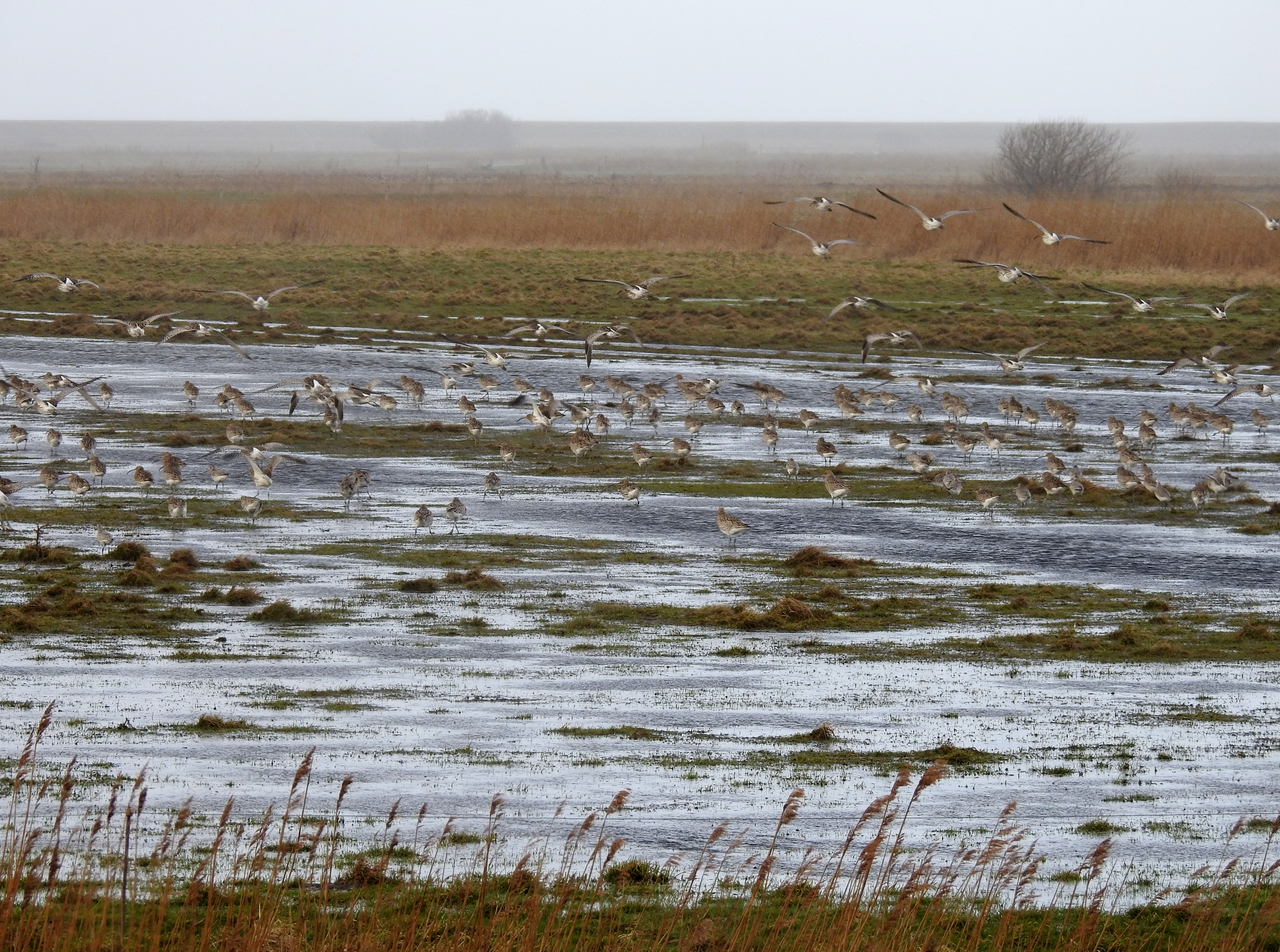
Mandø - curlews. Photo: Niels Knudsen
Margrethe Kog
Southern Jutland, by the Wadden Sea just north of the German border
Margrethe Kog is worth a visit all year round. In spring and autumn, large flocks of geese, ducks and waders forage here during migration – the enormous flocks of barnacle geese are a special attraction.
See Google map with outlook points, bird hide, car parks, etc.

Margrethe Kog seen from the seawall. Photo: Joy Klein
Description:
Margrethe Kog (‘kog’ means ‘polder’) was formed in connection with construction of a new seawall that was built in 1982 to protect the land behind from flooding. Since the seawall was built, new marshland has formed outside it. A third of the polder is covered by a salt water lake, into which seawater is pumped to ensure the correct salinity. The marshland is grazed by sheep. There are also a few smaller lakes, canals, clay pits and a water reservoir.
The Danish Nature Agency has recently implemented a large-scale project at the eastern side of the Kog with the aim of improving conditions for breeding meadowbirds and at the same time protecting the town of Tønder and its surroundings from the danger of flooding. Two islands for breeding birds have been established in the clay pits and the banks of the pits have been flattened. The water level is raised from April to June, and grazing is managed in such a way that the meadows meet the requirements of the breeding birds. Just two years after the project was implemented, the birdlife has increased. There is now a large avocet colony at the clay pits and common tern have begun to breed. At other places in the Kog, redshank, lapwing and godwit thrive. Even ruff have begun to breed in the area, which shows that water and bird-friendly management are the key to success.
Birds:
Margrethe Kog is especially known for the large flocks of barnacle geese that collect here. Up to 60,000 have been seen on one day, but it is more usual to see rather smaller flocks of around 20,000 birds. The largest flocks can be seen from the beginning of March to the end of April, and again from the beginning of September to the end of October. Red-breasted goose is seen nearly every spring. Even if this is a fairly colourful goose, it is surprisingly difficult to find one in the large flocks of grazing barnacle geese.
Ducks include shelduck, wigeon, gadwall, teal, mallard, pintail and shoveler.
All the common waders are seen in Margrethe Kog. The first to arrive in spring are lapwings, golden plovers, dunlins and curlews in tens of thousands. In May, knot, bar-tailed godwit, grey plover and ruff are seen. There are good chances of finding some of the less common waders such as Kentish plover, broad-billed sandpiper or red-necked phalarope. The best time to see waders is April/May/June and August/September/October. It is also an advantage to visit the area at high tide, when the waders roost in the salt water lake.
In winter, the area houses many geese and ducks. White-fronted geese and greylag geese are seen in increasing numbers. There are good chances of seeing raptors such as white-tailed eagle, peregrine and merlin. Other birds that turn up in winter are shore lark, twite, snow bunting and now and again lapland bunting.
Winter can offer some thrilling sightings of white-tailed eagle, that fly in to Margrethe Kog and the marshland in the morning in large numbers from their night roosts in the small woods a few kilometers north of Højer and Emmerlev. Before sunset, all the eagles fly back to their roosts. Up to 40 eagles can be spotted. Good observation posts are the Vidåslusen, Højer Sluse or Emmerlev Klev.
The area can also attract rarities: some species that have been spotted are gyr falcon, greater sand plover, ring-billed gull and citrine wagtail.
Visiting and access:
There is absolutely no access to Margrethe Kog south of the Vidå stream.
The best starting point for a visit is the town of Højer (route 419 westwards from Tønder or southwards from Ribe). In the town, signs lead to the sluice at Vidåslusen. Here there is a car park, an information centre and a cafeteria (temporarily shut down). From the top of the seawall there is a good view over both the northern part of Margrethe Kog and over the Wadden Sea stretching out from the seawall. An outside staircase leads to the top of the sluice tower, from where there is a fantastic view across both Margrethekog and the Wadden Sea.
From the sluice at Højer Sluse one can join the newly established Marsh Trail (Marskstien) which follows the dyke south along the eastern side of Margrethe Kog. The trail runs along the top of the dyke at the northern and southern ends, but the middle section is placed at the foot of the dyke so that breeding birds are not disturbed by the public. Around halfway along this stretch, however, it is possible to go through a gate and up a ramp to the top of the dyke to look down into the clay pits. However, it is important to be very careful when approaching the top of the dyke, so as not to disturb the birds that may be just on the other side.
One can also drive south from Højer along the narrow road that leads to Siltoft. Here there are two places where one can climb up onto the dyke on the east side of Margrethe Kog. The first place is a little south of the Vidå river, where a road just south of a group of houses leads west to the dyke. Here one can park and climb up onto the dyke. The other place is around 3km south of the river, where a road goes west to the dyke from a little junction. There is a gate across the road that has to be opened to reach the dyke. At the dyke, one can park and climb up the ramp as described above, to look down in the clay pits.
Finally, it is also possible to drive down to the German border at Siltoft. (Even if there is no border control, one should carry a passport). From here one can drive westwards between Margrethe Kog and Rickelsbüller Koog on the German side of the road. Here one can get close to the birds, especially if one stays in the car. About halfway out to the seawall there is a bird hide on the German side. One can park at the seawall and walk up to the top to look out over the Wadden Sea. One can also walk south along the side of the seawall with a view across Rickelsbüller Koog. The old border guard house at Siltoft has now been converted into a picnic house, with toilets, and with an exhibition about the area's nature, landscape and culture. It is open all year round during the daytime and evening.
It is recommended to visit Tøndermarskens English-language website for more information about the area. It is also possible to download a folder with a map about the trail and the various loops.

Barnacle geese at Margrethe Kog. Photo: Albert Steen-Hansen
Nørrestrand
East Jutland, immediately north of Horsens
Many waterbirds in the vicinity of a town
See Google map with look-out points, parking spots, etc.
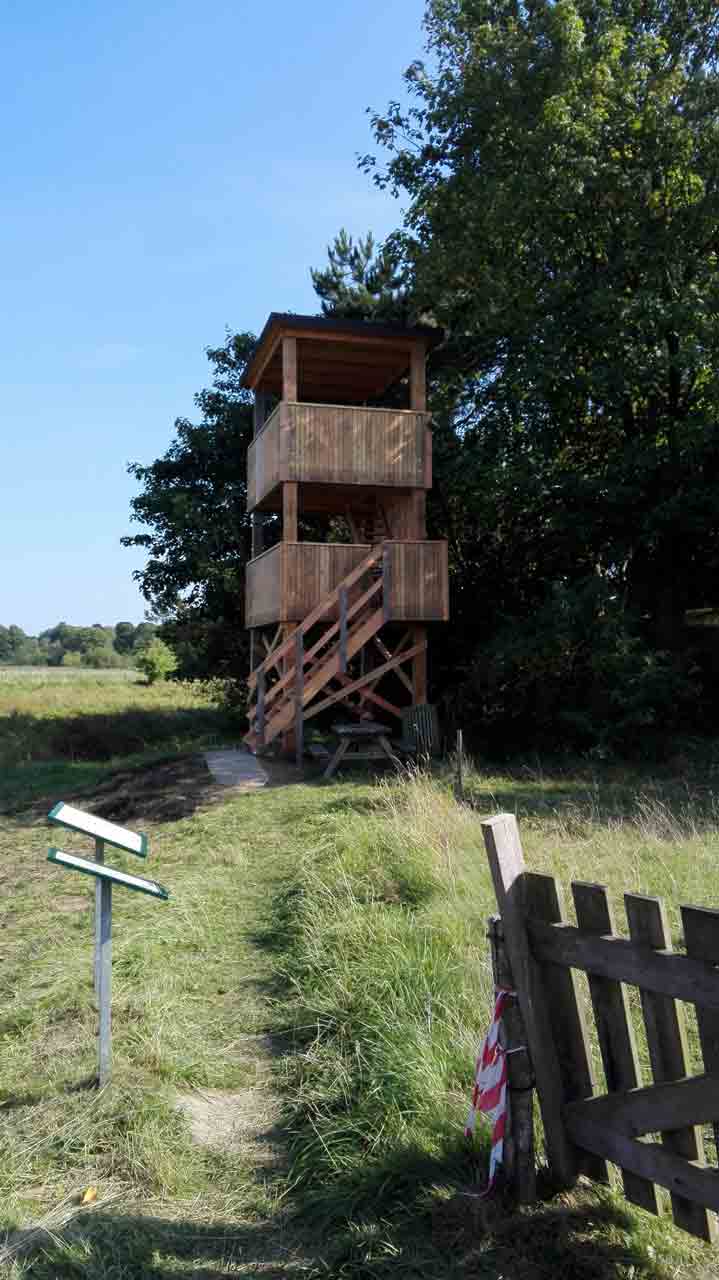
Nørrestrand - bird observation tower. Photo: Hans Pinstrup
Description:
Nørrestrand is immediately north of the town of Horsens. It is a former arm of Horsens Fjord, but is now a shallow brackish lake separated from the fjord by a sluice in Stensballe Sund. Along the southern boundary of the area is a built-up area and along the northern boundary is farmland with scattered buildings.
The lake itself covers around 120ha and is surrounded by large unbroken areas of reedbed as well as boggy scrub and woodland, mainly along the nature trail on the southern side. There are also some meadows, copses and small ponds. The area is managed by reed harvesting, felling willow trees and putting cattle out to graze the meadows, in order to preserve the varied wildlife and vegetation.
Birds:
Breeding birds:
There are several breeding waterfowl species, including little grebe, great crested grebe, greylag goose, shelduck, mallard, water rail and coot.
In the reedbeds are marsh harrier, sedge warbler, reed warbler and bearded tit. In the scrub, thrush nightingale, marsh warbler and grasshopper warbler. Lapwing and snipe nest in small numbers on the surrounding meadows. Kingfisher can be seen throughout the year.
There is a fairly large rookery next to the hostel on the southern side of the lake.
Migrating and staging birds:
Osprey visits the area regularly every autumn. White-tailed eagle can be seen all year round - often it is the pair from the nearby island of Vorsø that are on a visit. In summer flocks of sand martins, swallows, house martins and swifts can be seen hunting over the water.
In autumn Nørrestrand is a staging area for large numbers of greylag geese.
In winter, the lake is visited by whooper swan, mute swan, greylag goose, wigeon, pochard, tufted duck, goldeneye, smew and goosander.
Now and then one can be lucky enough to see some rarer guests, although only one or two at a time, for example black-necked grebe, gadwall, garganey, peregrine, little gull, black tern, white-winged black tern and Savi’s warbler. Bittern occurs regularly in winter.
Visiting and access:
Access is easiest from the southern side of the lake, where there is a nature trail. It is best to park at the end of Rønnevej (a little side road to Bakkesvinget, which is a side road to Langmarksvej, around 500m east of Forum Horsens). From here, the nature trail can easily be reached. The trail can be followed east/north-east to the bird observation tower, which stands immediately north of Lindskov Knude. From the observation tower there is a good view, especially over the eastern part of the area.
It is also possible to drive along Chr. M. Østergaards vej, which is a side road to Sundvej. This ends in Georg Rasmussens Vej, which can be followed east to a good outlook point, with a view over the eastern part of the area. It is also possible to drive a little further and park at the end of Georg Rasmussens Vej. Here one can cross Stensballe Sund by a little footbridge and walk along the south-easterly part of Nørrestrand. There are good parking facilities many places along the southern side of Nørrestrand.
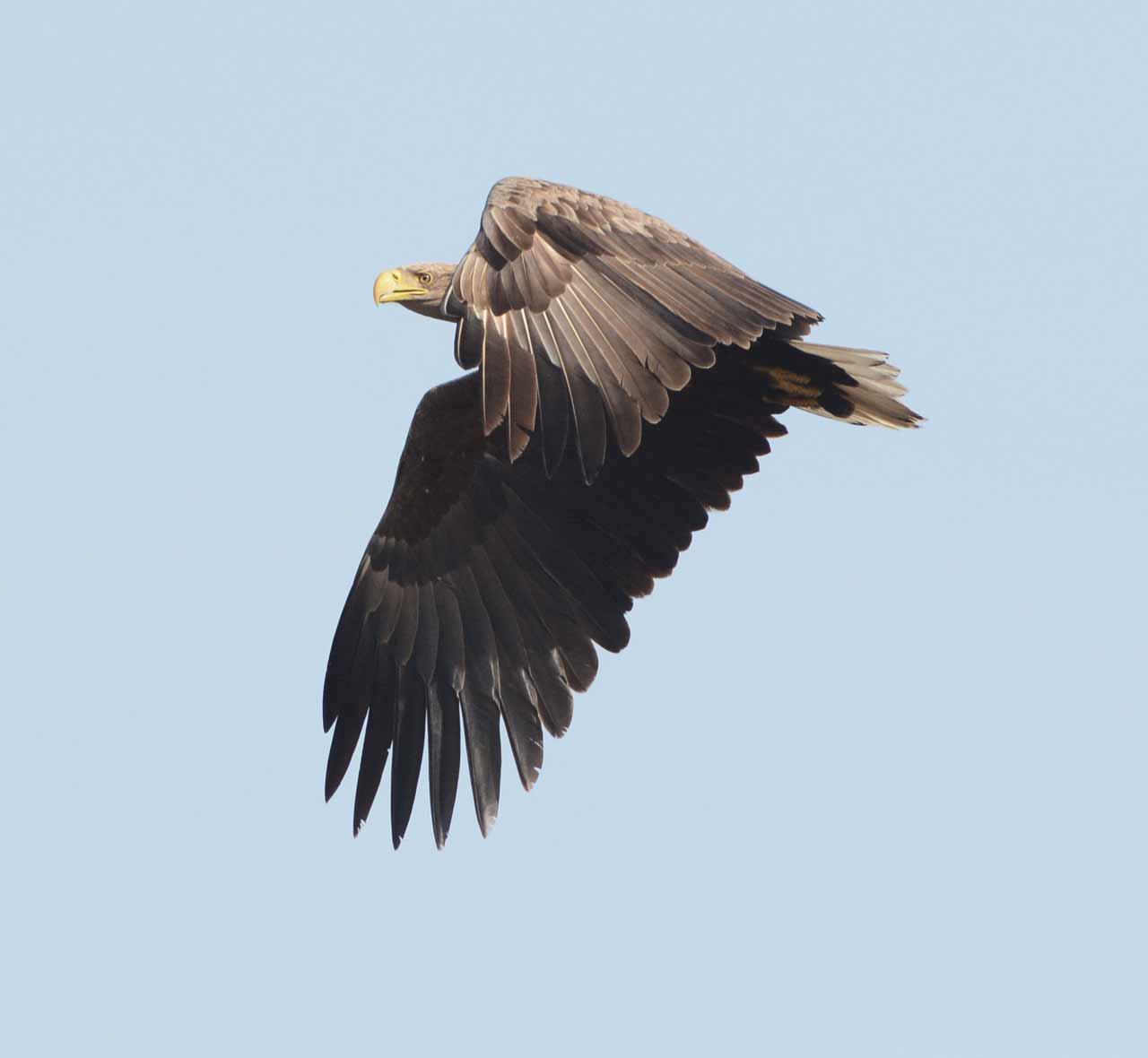
White-tailed eagle. Photo: Hans Pinstrup
Oldenor, Mjels Sø and Bundsø
Als, south Jutland
One of the most important bird sites in the east of south Jutland. Many bird species breed and stage here. Cormorant colony at Oldenor.
See Google map with car parks etc.
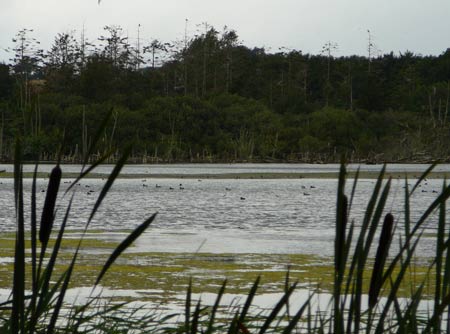
Description:
Oldenor, Mjels Sø and Bundsø are three lakes in the north of the island of Als. They were previously drained and cultivated but have recently been re-established. The northern part of Als is crossed by large trench valleys formed during the last ice age. They were turned into fjords when the sea level rose in the stone age. In the 17th and 18th centuries, the area became cut off from the sea, and in the 19th century work was started on draining the lakes. Work continued until after the second world war, when the drainage project eventually succeeded and the lakes were turned into cornfields. However, cultivation had to be given up in the 1980s when the land sank due to the drainage, and in 1993 the pumps were stopped and Oldenor was re-established. Since then it has turned into a valuable nature area. The lake and the surrounding meadows and woods are state-owned. In 2005, drainage of Mjels Sø was also stopped. The lake was re-established in co-operation with Aage V. Jensen Naturfond (who now own the lake), the Nature Agency, and local authorities.
Finally, Bundsø was re-established in April 2015 as part of a state project for removing nitrogen from the acquatic environment. Bundsø was purchased by Aage V. Jensens Naturfond in January 2019. It will be interesting to see which measures the fund will plan and implement during the coming years.
Birds:
Breeding birds:
There is a large colony of cormorants at the western end of Oldenor, that have made their mark on the nesting trees, which have now almost completely collapsed. The cormorants still nest on the same spot but in willow bushes and in the remains of the destroyed trees. Other breeding birds include great crested grebe, greylag goose, shelduck, mallard, water rail, moorhen and coot. Mute swan breed here but the number of pairs varies from year to year. A few grey herons have built nests in the cormorant colony.
The cormorant colony, which formerly numbered around 200 pairs, has since been split up, with one part remaining at Oldenor, but a new colony of around 150 pairs forming at Bundsø.
A pair of white-tailed eagles started breeding in 2009 but have not bred the last few years. Brandsbøl Skov, where the nest is placed, is a private wood and it is possible that the eagles have been scared away by too much activity, including tree felling. The eagles still visit Bundsø and Oldenor, where they mostly can be seen in the cormorant colony.
Buzzard also nest in the trees near Oldenor. Goshawk probably breed in the vicinity, as juveniles are seen here regularly.
Mjels Sø supports breeding great crested grebe, mute swan, greylag goose, mallard, moorhen and coot, and a pair of sparrowhawks nest nearby. Egyptian goose with young were spotted in 2021.
Kingfisher is seen regularly at Mjels Sø and Mjels Vig and most probably breeds here.
During the first year of Bundsø's existence, breeding birds have comprised great crested grebe, red-necked grebe, mute swan, greylag goose, shelduck, coot, little ringed plover and lapwing.
Migrating and staging birds:
Oldenor attracts many staging ducks for a great part of the year. Wigeon and tufted duck, especially, can be seen in their hundreds, but smaller numbers of shelduck, gadwall, teal, shoveler, pochard and goldeneye can also be observed. Other staging birds include great crested grebe, grey heron, mute swan, coot, and large flocks of common gull and black-headed gull. Great white egret appears in increasing numbers - now as many as 15 individuals. In winter, goosander are seen, together with a few smew, scaup and goldeneye. Several species of raptor can be spotted at Oldenor, for example marsh harrier, sparrowhawk and buzzard. Osprey can turn up during the migrating period.
The same species can be observed at Mjels Sø. In autumn, there are often more birds in Mjels Sø than in Oldenor. Species such as gadwall and shoveler, for example, seem to prefer Mjels Sø. Increasing numbers of pochard are spotted, sometimes more than 200. Goosander and smew can be more numerous at Mjels Sø. A few great white egret visit the area.
Bundsø attracts the same species of duck. There are many staging geese, including up to 1000 greylag geese and up to 300 white-fronted geese. A small number of great white egret are also seen here.
Some of the more unusual migrating and staging birds spotted in the area include great white egret (up to 12), red-crested pochard (2018), ruddy shelduck (2012) and snow goose (2013).
Visiting and access:
Oldenor can be reached from Oksbøl south of Nordborg at the northern end of Als. A minor road (Tvendalvej) leads west from the main road at the northern end of Oksbøl (in the direction of Mjels). After around 2km one reaches a car-park, from where a path leads east to an outlook point with a fine view over the lake. From the car-park one can walk along a path that follows the banks of the lake westwards. In this way one can come closer to the cormorant colony at the western end of the lake. By continuing along the path (follow the “E Govl” sign) east of Mjels Vig one comes to a car-park at the western end of Mjels Sø. The old pumphouse now houses an information centre illustrating the re-establishment of the lakes. Outside the pumphouse is a picnic area. From here one can either follow the road back to the car-park at Oldenor, or continue along the Mjels Sø path along the northern edge of the lake. The car-park at Mjels Sø can also be reached by car by continuing along the minor road from Oksbøl to Oldenor, or by driving north out of Mjels.
There are three car-parks at Bundsø. The first can be reached from the main road, Oksbølvej, south of Nordborg. A short road leads off at an angle to the car-park. However, there is not much room here, and only the eastern end of the lake can be seen from here. The second car-park can be reached by driving around another 375m eastwards along Oksbølvej and turning right to reach the Vesterballe road, turning right again in the direction of Brandsbøl Skov. After just under 1 km, a steep road leads down to the car-park. Here, there is plenty of room, a picnic area and an information board, and most of the lake can be seen. From the car-park, two paths lead off - one going west, and one going round the eastern end of the lake. By following the path going west one can reach a new bird observation tower after about 500 m. From here there is a good view over the lake. The third car park can be reached from Søholmvej in Broballe at the western end of the lake. There is plenty of room here and a good view over the western section of the lake.
It is recommended to use the Nature Agency’s folder with map of the area, that can be downloaded here.

Pochard. Photo: Klaus Dichmann
Pamhule Skov and Hindemade
South Jutland, west of Haderslev
A good locality for woodland birds and for spotting white-tailed eagle and osprey
See Google map with look-out points, car parks, etc.

Pamhule Skov and the Bibæk stream. Photo: Joy Klein
Description:
The wood of Pamhule Skov covers an area of around 300ha. Over half the wood consists of beech trees, the rest being oak, ash and various conifers including Norway spruce and Douglas fir. The wood is now left untouched - trees are left to die and rot and some trees have been destroyed with explosives - a heavy-handed method, but aimed at improving conditions for fungi and insects. It is planned to remove the imported species such as Douglas fir and Sitka spruce with the next few years. A few new ponds have been established.
The plant life on the woodland floor is rich and includes many species of sedge, including the rare pendulous sedge (Carex pendula). A stream – called the Bibæk – runs through the wood and has its outlet in the lake of Hindemade. From the outlook point “Udsigten”, which is one of the highest spots in the wood, there is a view over the two lakes of Hindemade and Haderslev Dam. There is also a fine view from Dronning Margrethe II’s Udsigt in the deer park, which is just east of Pamhule Skov.
Hindemade, west of Haderslev Dam, was originally a boggy area crossed by the stream of Tørning Å. The bog was drained in the 1930s and cultivated up to the start of the 1990s. In 1994 the area was re-established as a nature area. Drainage was stopped, Tørning Å regained its former bed, and a new wetland was established. There is now an area of 45ha under water and 5 bird islands have been established in the middle of the new lake.
To the north-west of Hindemade is the Christiansdal hydro-electric power station with a dammed up pool, and even further to the north-west the mill of Tørning Mølle with a millpond.
Birds:
Breeding birds:
Pamhule Skov has been designated as a Natura 2000 area, with special regulations to protect woodland birds. The wood supports birds such as honey buzzard, buzzard, goshawk, sparrowhawk, green woodpecker, great spotted woodpecker, black woodpecker and raven.
Kingfisher and grey wagtail are often seen at Hindemade and along the Bibæk stream, and Christiansdal and Tørning Mølle are also good places for spotting these two bird species.
In the lake of Haderslev Dam there is a large colony of black-headed gulls. Common tern has nested here for many years, and Mediterranean gull has also started to breed.
The islets in the lake of Hindemade are breeding sites for a few pairs of common tern, oystercatcher and in recent years avocet. The young avocets can be seen feeding on the mudbanks in front of the bird observation tower.
A pair of white-tailed eagles have nested near Haderslev Fjord for many years, and in 2022 a new pair started nesting in a private forest in the area. Red kite has also bred nearby and is often seen over Hindemade.
Migrating and staging birds:
Large flocks of ducks and geese can be seen on Hindemade all year round. Greylag goose is especially numerous, with almost 2000 birds being spotted at one time.
In the migrating season April-May and September, osprey is a frequent guest. It is often seen fishing over the small ponds west of Hindemade.
Rare birds sometimes turn up. Both cattle egret and blue-winged teal have been spotted at Hindemade.
Visiting and access:
Leave the E45 motorway at exit 68 west of Haderslev and at the roundabout take the road for Hammelev, after which follow the signs for Christiansdal. On the way is a sign to Hindemade. Turn onto this gravel road and after about 1km one reaches the lake, where there is a car park. A 3km long trail leads round Hindemade with good views over the lake. In the south-west corner of the lake is a bird observation tower. From the car park, one can also follow the "red route" westwards to reach Christiansdal and further on (passing under the motorway) Tørning Mølle (around 2½km).
Pamhule Skov is south of Hindemade and there are several places to park, for example at Nørskovgård at the end of Nørskovgårdsvej (turn west off Erlevvej north of Marstrup). Here there is nature playground, a barbecue area and toilets. From here, one can walk to the viewpoint of Dronning Margrethe IIs Udsigt and then follow the "yellow route" to gate 4 in the deer park fence to enter the wood of Pamhule Skov.
It is recommended to use the map in the leaflet published by the Nature Agency, which can be obtained at tourist information offices or downloaded here (scroll down to the bottom of the page for a link).

Kingfisher. Photo: Helge Sørensen
Rømø
South-west Jutland, in the Wadden Sea west of Skærbæk
From the island of Rømø, the enormously rich birdlife of the Wadden Sea can be experienced at close range. The mudflats and marshes around the island are of international importance for ducks and waders. Several rare and threatened bird species breed on the island.
See Google map with car park etc.

Kentish plovers. Photo: Helge Sørensen
Description:
Rømø is the most southerly of the Danish Wadden Sea islands. Originally the island was just a sand bank, but it gradually grew up out of the sea – and is still growing, mostly on its western side where sand is still being deposited.
Rømø offers many different landscapes in a very small area: not just mudflats, sandy beaches and marsh, but also sand dunes, heath, plantations, coastal meadows and ponds. Large areas of the island have been appointed EF bird protection areas, EU habitat areas and Ramsar areas, and the Stormengene (the Storm Meadows) in the south are owned by the Danish Bird Protection Foundation. The Danish Nature Agency has carried out a project which should ensure that the heaths on the dunes remain open and treeless.
Birds:
Breeding birds:
In the area around the lake of Lakolk Sø there are nesting bitterns, marsh harriers, bearded tits and water rails. Nesting shelduck, oystercatcher, redshank and lapwing can be seen on the Stormengene together with many passerines such as yellow wagtail and meadow pipit. Several species of duck breed on Rømø, for instance teal, pintail and shoveler.
The most important breeding ground in Denmark for the extremely rare Kentish plover is to be found on Rømø. Little tern and arctic tern also breed here - in some years in good numbers, in others with only a few, small colonies, which furthermore can easily be wiped out by extraordinary high tides. (This can also happen to the Kentish plover). On the coastal meadows, a few pairs of the southern variety of dunlin (Calidris alpina shinzii) are still to be found nesting: this is the only site in the whole of the Wadden Sea region. Ruffs occasionally breed here, too. Modest numbers of bearded tit, grasshopper warbler and whinchat nest in the open countryside. Stonechat and bluethroat now breed regularly. The plantations support kestrel, long-eared owl, woodlark and red-backed shrike. In Kirkeby Plantation and Vråby Plantation, nightjars can be heard in June and July.
Migrating and staging birds
Bird migration tops in March/May and August/October. Both spring and autumn, hundreds of thousands of birds – primarily waders – rest on the island’s mudflats. Dunlin form the biggest flocks, but knot, oystercatcher, curlew, whimbrel, bar-tailed godwit, golden plover, redshank, avocet and greenshank also appear in large numbers. It is not unusual to see more than 20 different species of wader on a single day. Geese can also be observed: the most numerous being barnacle goose, greylag goose, brent goose and pink-footed gooose. The numbers of geese have been increasing regularly. There are many barnacle geese, especially at Juvre, but a number of white-fronted geese can also be observed. Wigeon, mallard, teal, pintail and shelduck are the commonest species of duck. The commonest raptors are rough-legged buzzard, marsh harrier, peregrine and merlin, and white-tailed eagle is now seen regularly.
Along the west coast of Rømø, large flocks of staging diving ducks (common scoters and eiders), migrating or staging gulls and terns, and sometimes seabirds such as gannets, can be observed, especially during the autumn months.
In autumn, the southerly point of the island is a good spot to see many migrating passerines and raptors. Many passerines also settle on the southern end of the island – at Stormengene – until they continue their migration southwards. In autumn, the bushes and scrub here are good places for finding passerines - including some rare ones.
Large flocks of greylag geese stay on Rømø during mild winters, together with a large number of ducks. A recent phenomenon is the considerable increase in the number of staging barnacle geese. More than 50,000 birds can be observed from the embankment leading across to Rømø. In winter, flocks of shore lark, twite and snow buntings can be spotted.
Visiting and access:
Route 11 leads to Skærbæk, from where one drives west over the embankment to the island. There are many roads and paths on Rømø, but there is only limited access to the military area at the north of the island. In the breeding season there is no access to Stormengene or Lakolk Sø. It is also prohibited to enter the fenced-off areas on the beach (where Kentish plover and little tern breed). It is also advisable not to walk across the coastal meadows in the breeding season, or to go out on the mudflats if there are flocks of birds there.
The best places to see birds are the car parks along the Rømø embankment – especially at high tide, when waders forage close to the embankment; Lakolk Sø (there is a good view across the lake from the road); Stormengene (the Danish Bird Protection Foundation’s reserve); Vråby and Kirkeby plantations; and at the harbour in Havneby, where the southernmost jetty offers views across the nature reserve of Helm Odde. There are also fine observation points at Juvre at the north of Rømø, particularly from the dykes. Here, however, one must be aware that large parts of Nørreland and Juvre are military areas, with limited acccess for the public. It is possible to enter the area, but only in certain places and at certain times. One must ask locally to find out what is possible.
It is recommended to use the Nature Agency's folder with map of the area, which can be downloaded here.
The most important thing to bear in mind when bird-watching in the Wadden Sea is that the best time is around high tide (+/- 2 hours).
In Tvismark, the Tønnisgård Nature Centre has an exhibition about the island’s birdlife and nature.
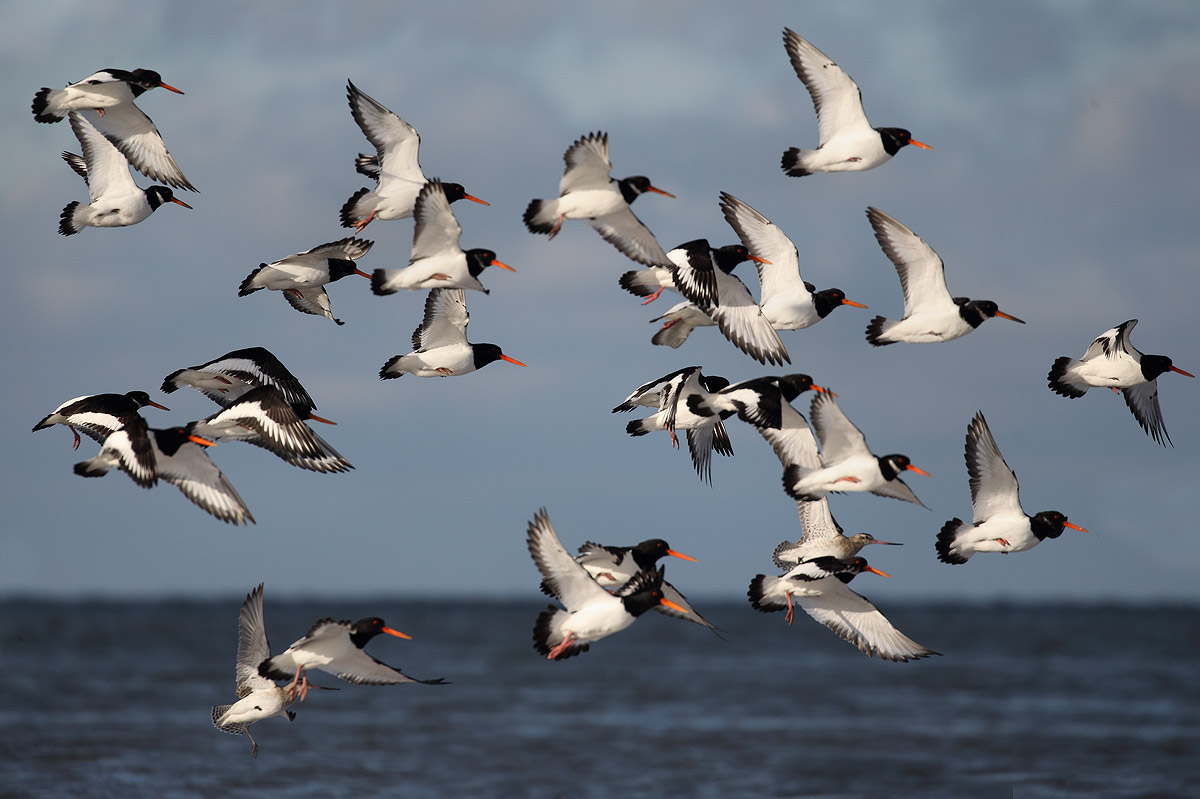
Oystercatchers. Photo: Steen E. Jensen
Skallingen, Langli and Ho Bugt
South-west Jutland, south-east of Blåvandshuk
The whole area is a very important staging site for ducks, waders and raptors for most of the year. Langli is a breeding locality for large colonies of herring gulls and lesser black-backed gulls
See Google map with car park etc.
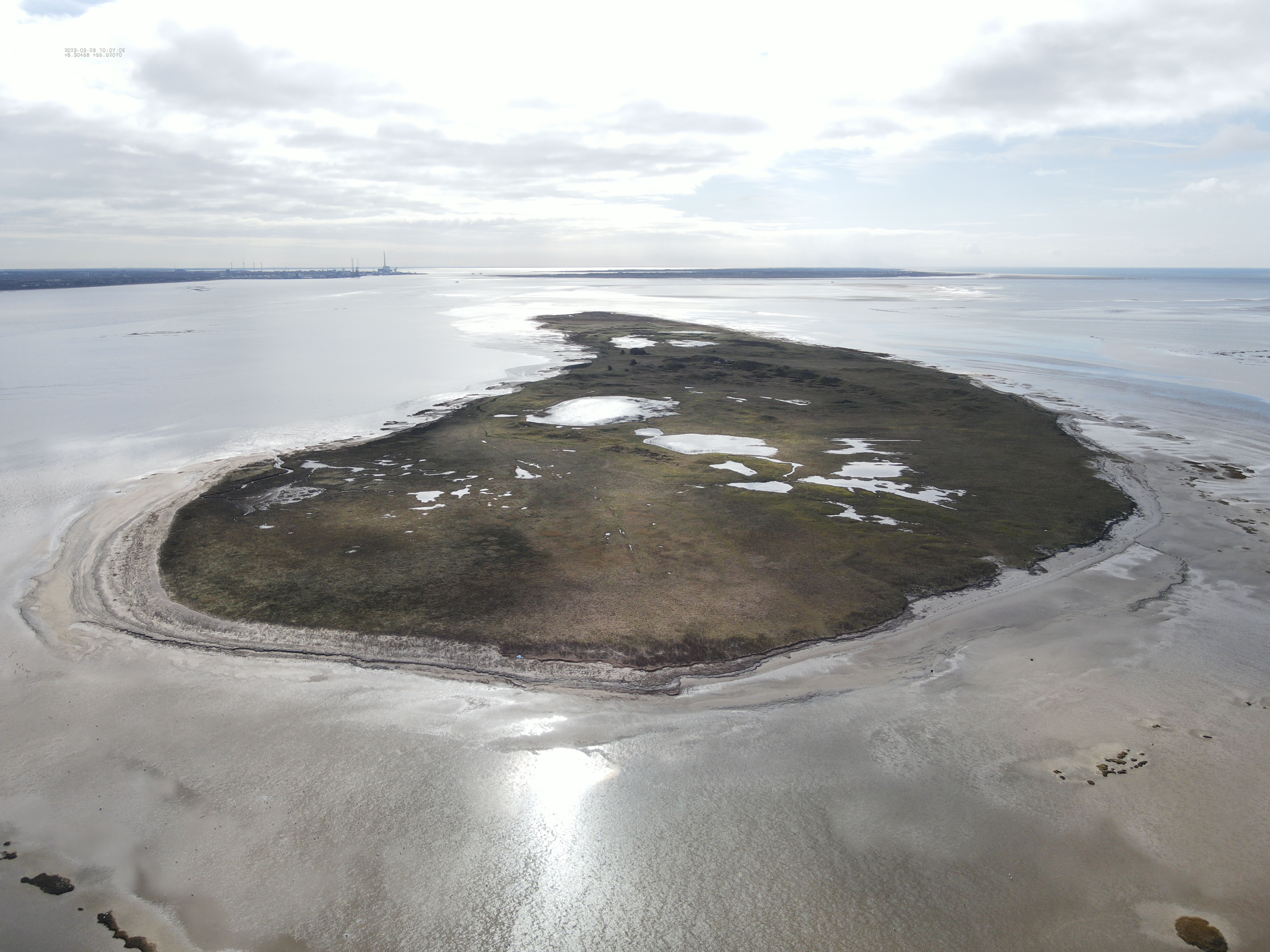
Langli seen from the air. Photo: Lars Maltha Rasmussen
Description:
Skallingen is a peninsula south-east of Blåvandshuk and is bordered by the North Sea to the west and the bay of Ho Bugt to the east. Langli is an island covering around 70 ha in the middle of Ho Bugt.
Skallingen has been gradually formed by the sea over a period of 300-400 years. The peninsula is 2-3km wide and 8km long. The western side is sandy beach and dunes that have been created by the sand carried south from Blåvandshuk by the currents in the sea. The eastern side is a belt about 2km wide with marshland, formed by material deposited by the sea at high tides and now overgrown. There are no trees or bushes, and the area is grazed by cattle and horses. Skallingen is often flooded in winter. The sea has begun to erode the coastline on the western side of the peninsula.
The island of Langli is what remains of an old peninsula that became cut off from the mainland during a flood in 1634. The northern and southern ends of Langli are marshland, while the middle of the island is dominated by dunes up to 16m high.
Skallingen, Langli and the deep channel Hobo Dyb east of Langli are under protection orders and have been designated as EF bird protection areas and Ramsar areas. Skallingen is an international research centre for marsh formation, and the area between Skallingen and Langli is an area of scientific reference, where access is prohibited.
Birds:
Breeding birds:
The most important bird populations are to be found on Langli. There were formerly over 9,000 pairs of herring gulls and 2,400 pairs of lesser black-backed gulls, but the number has been reduced considerably since 2015. The commmon gull colony has been reduced from 2,700 pairs to 135 pairs in 2023 and black-headed gull now only breed occasionally. Other birds that breed in colonies such as arctic tern and avocet has disappeared. A formerly dense population of breeding oystercatchers, with up to 240 pairs in 2006, has sunk to only 60 pairs in 2023. There were formerly up to 50 pairs of spoonbill on Langli, but these have also disappeared. Up to 200 pairs of eider duck breed here, but the former population of barnacle goose has disappeared. The reason for the reduction in numbers of herring gull is partly due to foxes breeding on Langli in 2020 and 2021, but the closing down of many mink farms and restrictions on shrimp fishing have had even more effect. Spoonbill, barnacle goose and eider duck have suffered from the foxes, whilst the other breeding birds have suffered from the many herring gulls.
Skallingen is a breeding site for a fewf waders (especially redshank and oystercatcher) and ducks.
Migrating and staging birds:
Large flocks of ducks and waders stage in the area during the autumn migration, winter and spring. Pintail is the commonest dabbling duck, with numbers of up to 3000. In Ho Bugt, brent geese, shelducks and wigeon can be seen. Waders stage in large numbers in the area, for example bar-tailed godwit, oystercatcher, golden plover, curlew, dunlin, knot and sanderling. Many grey herons and several great white egrets can be seen on Skallingen. Staging raptors include white-tailed eagle, marsh harrier, hen harrier, rough-legged buzzard, peregrine and merlin.
Other animals:
On the sandbanks off the coast one can see both common seal and grey seal. Otter is now a regular visitor to Skallingen. On Langli there is also a dense population of hare.
Visiting and access:
From route 431 between Varde and Oksby, a minor road (Hovej) leads southward to the village of Ho. Skallingevej continues out to Skallingen, where there are two car parks. The most southernly is next to the former lifeboat station (now called “Madpakkehuset”, which means "packed lunch house”!), where there are indoor picnic facilities, toilets, and an exhibition about the area. From here, one can walk along a cart track og along the beach to the end of the peninsula. The very tip of the peninsula is, however, closed to all access.
In the village of Ho, one can also turn left onto a road (Sønderballevej) towards Nyeng, with a view across Ho Bugt. From here one can walk along a 4km long causeway out to Langli, but access is only permitted 16th July – 15th September. However, it requires a good knowledge of the tides and the weather forecast.
It is not allowed to take dogs onto Skallingen or Langli because of the birds and the wildlife. Access to the area of Hobo Dyb between Skallingen and the causeway to Langli is prohibited all year round.
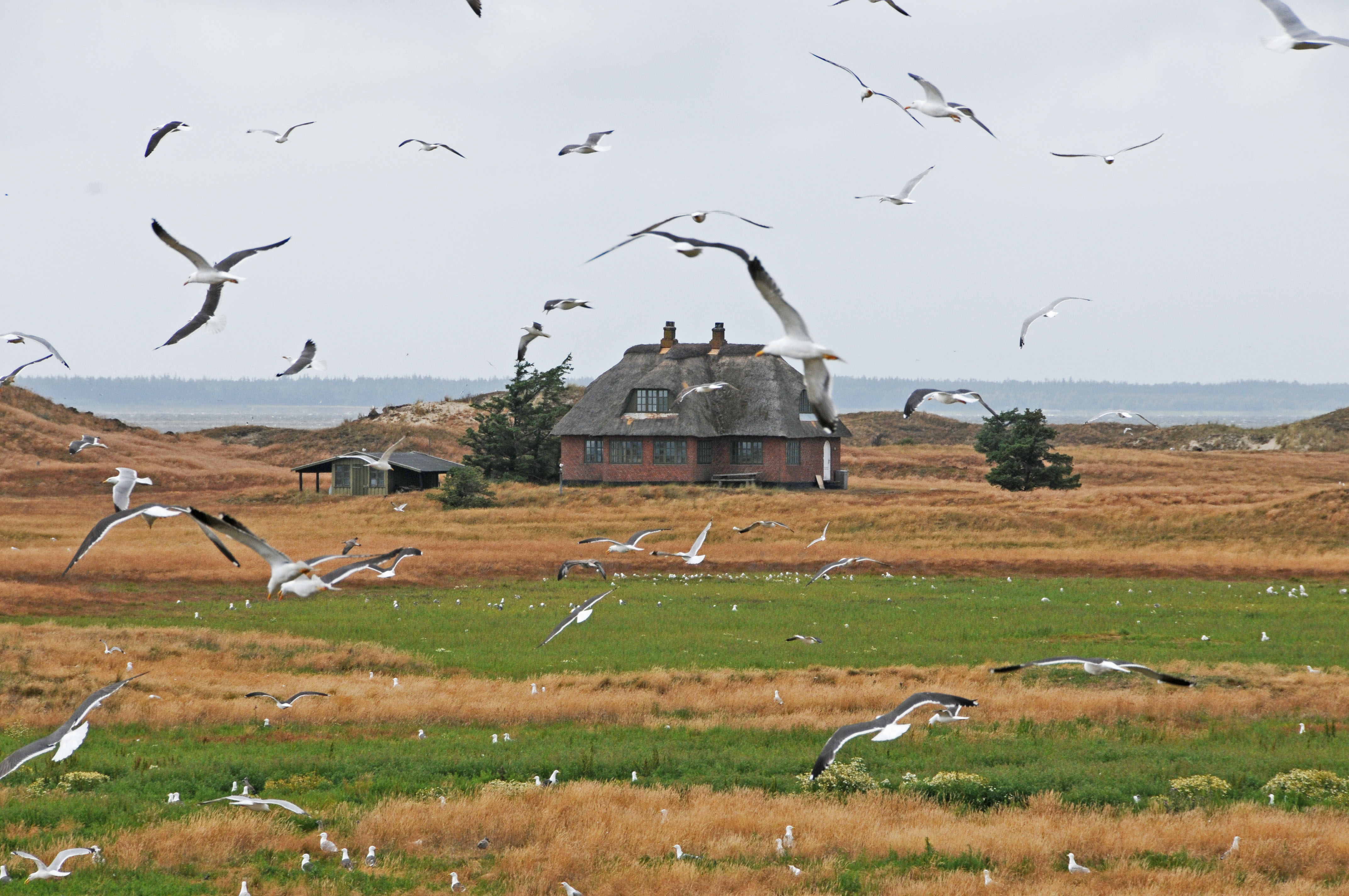
Herring gulls and lesser black-backed gulls, Langli, July 2009. Photo: Lars Maltha Rasmussen
Skjern Å valley
West Jutland, east of Ringkøbing Fjord
Birds in large numbers all year round
See Google map with outlook points, bird observation towers, car parks, etc.

The Skjern Å valley with Lønborg church in the background. Photo: Joy Klein
Description:
The river of Skjern Å is the river with the greatest volume of water in Denmark. It enters the lagoon of Ringkøbing Fjord by Denmark’s largest delta. The area described here covers the last 20km of the river’s course between Borris and Ringkøbing Fjord.
In its present form, the western part of the Skjern Å valley is the result of the largest and most expensive nature re-establishment project ever carried out in Denmark. As was the case for so many other areas in Denmark, the valley was the object for one of the great projects intended to transform wetlands into fertile arable land. In the course of the 1960’s, an enormous drainage project was carried out. 4000ha of meadow and marshland were converted to arable land. Only 30 years later, it was decided that 2200ha of the area – from Borris to Ringkøbing Fjord – should again be transformed to meadows and wetlands. The project was initiated in 1987. It comprised moving the river back to its old, meandering course and stopping the canalisation and drainage. The project was completed in 2003 and the area is now a large nature area with lakes, reedbeds, meadows and the winding river. The largest lake is Hestholm Sø, east of the road between Lønborg and Skjern, which crosses the river valley.
To keep the landscape open and to create the best possible conditions for the valley’s rich birdlife, especially waders and ducks, it is necessary for the meadows to be grazed by cattle and/or mowed for hay. Undesirable bushes should also be cut down and removed. The present level of management is however insufficient to keep the landscape open and needs to be intensified.
Birds:
As early as the end of May 2006, only four years after the nature re-establishment project was completed, 248 bird species had been observed in the Skjern Å valley. This number has now risen to 274. All year round there are impressive numbers of cormorants, grey herons, mute swans, greylag geese, coots and many species of duck to be seen.
Breeding birds:
The first birds to breed every year are greylag goose and mallard. Later on, shelduck, gadwall, garganey and shoveler begin nesting. Pochard and tufted duck nest in the shelter of the black-headed gull colonies. The colonies have, however, become greatly reduced due to a rise in water level, and black-necked grebe no longer breed here. Great crested grebe is still a breeding bird. The bittern can be heard in the reedbeds and marsh harrier hunts over the meadows. One of the most exciting birds is the spoonbill, which started breeding here in 2002. The spoonbill colony on the island of Høje Sande just off the Skjern Å delta is the largest in Denmark. In 2021 a total of 377 nests were counted. Great white egret is present throughout the year, and up to 35 birds have been seen at a night roost at Lønborggård/Stavsholm. Up to now, however, it has only been seen to breed once, namely in 2019 on Vesterenge. Many waders nest here, the most visible being oystercatcher, avocet, lapwing and redshank. Water rail breeds in the reedbeds and can be heard every year in different parts of the area. Spotted crake probably breeds here, as it can be heard in many suitable biotopes every year.
Passerines include bluethroat (race cyanecula), which has established itself as a breeding species here during the last 10 years and numbers several pairs, as well as grasshopper warbler and willow tit (race salicarius). One to two pairs of penduline tit have bred here the last few years. Bearded tit nests every year around the largest lakes and in the reedbeds at the delta where Skjern å runs into Ringkøbing Fjord.
White-tailed eagle has nested in the vicinity of the area since 2010 and can daily be seen hunting in the western part of the valley (from Skænken Sø to Ringkøbing Fjord) throughout the year, often joined by vagrant younger eagles.
Migrating and staging birds:
Both spring and autumn, waders stage here in large numbers, the most numerous being golden plover, lapwing and snipe. Exceptional numbers of ruff stay over here on their way to their breeding grounds. They are already decked out in their colourful feathered collars. Dotterel stage over here every year in May, with up to 300 birds flocking on the fields north of the valley (the fields at Falbækvej and Holter). In autumn and in mild winters, the same fields host small flocks of shore larks.
Since 2016 there has been a relatively stationary population of 1-35 great white egrets, which have chiefly been seen in the areas of Vesterenge, the Hestholm lakes and Skænken Sø. The last few years they have also been seen further eastwards on the Damsø meadows, Albæk Fælled and Albæk Mose. They have been observed flying to night roosts at Lønborggård/Stavsholm, Skænken Sø and Øster Hestholm.
Osprey is seen in the area in April and again in August-September. In the winter months there are chances of seeing white-tailed eagle and peregrine. Other raptors seen regularly over the Skjern meadows are hen harrier, buzzard, rough-legged buzzard, kestrel and merlin. Red kite has started to turn up in spring and autumn the last few years.
In winter, the valley attracts whooper swan, Bewick’s swan, bean goose, pink-footed goose, greylag goose and barnacle goose. White-fronted geese are often observed with up to 100 individuals. Thousands of ducks spend the winter here and wigeon, gadwall, teal, mallard, pintail and shoveler can be seen. Diving ducks include tufted duck - often in large numbers - with goldeneye, pochard, scaup, goosander and smew being seen yearly but in much smaller numbers. The rare ring-necked duck has been observed the last six winters.
Visiting and access:
Lønborg, which is situated on route 423, west of Tarm, is a good starting point for a visit to the area. From the grassy slope of Lønborg Banke below the church there is a fine view over the valley. The road between Lønborg and Skjern crosses the valley and here there are several car parks with good views of the area. There are several bird observation towers in the area and all this part of the valley is criss-crossed by paths. Some of the paths have hard surfaces and are therefore suitable for wheelchairs and bicycles. It is a good idea to obtain the Nature Agency’s leaflet with a map of the area, which is available in English and can be obtained at tourist information offices or downloaded here.
The best observation points are as follows (numbers correspond to the numbers on the Nature Agency's leaflet):
1. Pumpestation Nord (the northern pumpstation), which has been renovated and has a partly covered top storey which offers protection against wind and rain and a view over the western section of the meadows. There is a staircase and a lift up to the top. The pumpstation is reached from the Skjern-Lønborg road by driving off along Falbækvej, where there is a signpost to the pumpstation.
2. Lønborgtårnet is a completely enclosed tower, which can be reached by a path leading from Lønborggårdvej. There is a boardwalk along the wettest section of the path.
3. Hestholmtårnet is a tower situated on the east side of the road between Skjern and Lønborg. The tower has recently been renovated, with a new staircase and a disabled-friendly ramp.
4. Pumpestation Sydøst (the south-east pumpstation) is a renovated pumpstation on which an observation platform has been erected, with a view over most of the Hestholm lake. A gravel road leads north from Bøelvej and up to the pumpstation.
5. Øster Hestholmtårnet is a new, covered tower, with a view to three sides. The tower is inside a cattle enclosure so one must share the path out to the tower with the cattle. As the water level in Hestholm Øster has been very high the last few years, it is absolutely advisable to wear rubber boots. Even then, it may be difficult to reach the tower in the winter season.
6. Pumpestation Øst (the eastern pumpstation) has a partly enclosed top storey, with a really good panorama over the eastern part of the valley. The pumpstation, which is north of Skjern Å, can be reached by a gravel track turning east off the A11. It can also be reached along Ånumvej which runs east-west, north of the pumpstation.
The Skjern Enge Nature Centre, run by the Danish Nature Agency, has an exhibition on birds. The centre's address is Gammel Botoftevej 4, 6880 Tarm and is open every day from 11.00 a.m. - 5 p.m.

Marsh harrier. Photo: Helge Sørensen
Sneum Digesø
West Jutland, next to the Wadden Sea, south of Esbjerg
A rich birdlife in an artificial lake
See Google map with car park etc.
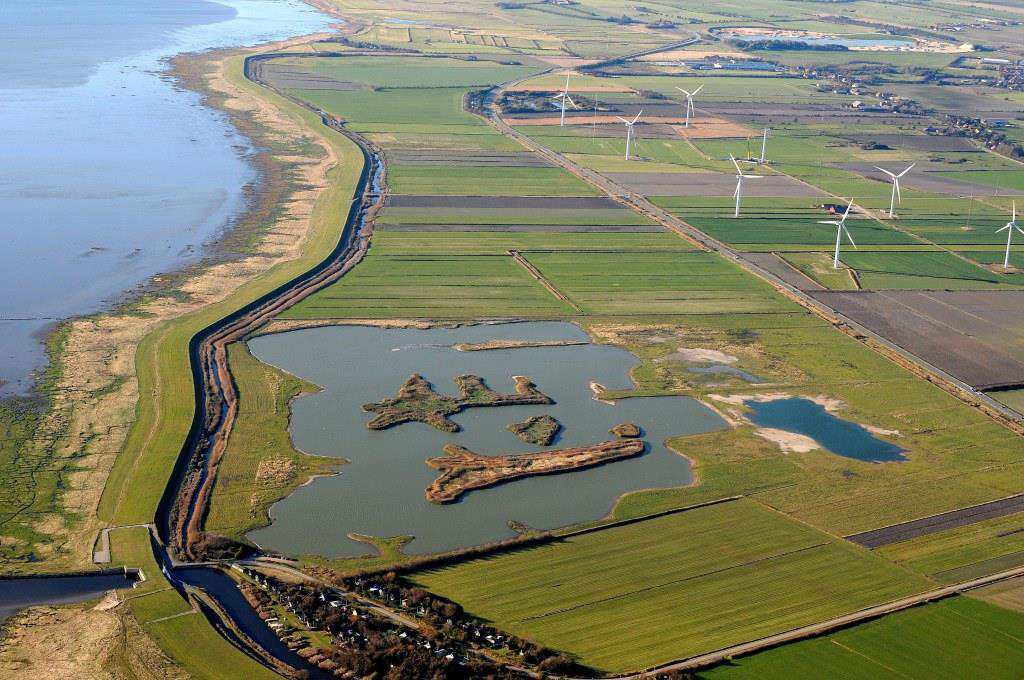
Sneum Digesø - Tjæreborg Enge. Photo: John Frikke
Description:
Sneum Digesø is an artificial lake that was created in connection with a project started at the beginning of the 1990s, the primary aim of which was to reinforce the Darum-Tjæreborg seawall. The seawall was built in 1929 after floods in 1909 and 1911, and was now reinforced by making the seaward slopes longer and flatter. This entailed the destruction of the natural landscape on the foreland. In compensation, 56ha of marshland behind the seawall was purchased and here clay was excavated (more than 200,000 m3). This was used to reinforce the seawall, at the same time creating an extensive area with lakes. Planning ensured that the area was bird-friendly, and the lake was excavated in such a way that there were some parts with shallow water and islands, promontories and inlets. The birds thereby had good, protected breeding and staging areas.
The lake covers 26ha and the whole area is nearly 60ha. It is planned that excavations will be taken up again when new material for the seawall is needed. The lake can therefore become even larger in time. The meadows around the lake are grazed by cattle in the summer, thus preventing the growth of reeds and scrub. In addition, most of the vegetation on the islets in the lake is cut down each winter, so that the islets offer a perfect nesting site for the many breeding birds that arrive in spring.
Birds:
Many birds use Sneum Digesø and the meadows throughout the year, both for breeding, staging and foraging. A study made in 2010 showed that of the 69 newly established lakes in Denmark, Sneum Digesø had the greatest variety of birdlife, with no less than 264 different bird species observed since the lake's completion in 1995.
Breeding birds:
Black-headed gulls have taken over the small islands and made large colonies. As they are very watchful towards enemies, they are a good protection for other breeding birds, such as greylag geese, mallard, shoveler, coot and oystercatcher. Avocets nest at the lake in good numbers. Smaller numbers of great crested grebe, black-necked grebe, shelduck, gadwall, garganey, tufted duck, Mediterranean gull and common tern also breed here. The adjacent reedbeds are home to marsh harrier and bluethroat and on the meadows around the lakes are lapwing, redshank, meadow pipit and yellow wagtail.
Sandwich tern was at one point a new addition to the breeding bird species. They started to nest among the black-headed gulls on the western island in 2011 and by 2012 the little colony had grown to around 80 pairs. However, the population declined and the birds no longer breed here. They can still be seen foraging in the area every spring, however, so they may possibly try to breed again at some point. In contrast, the population of Mediterranean gull, which is a new breeding bird for Denmark, has grown steadily after 2000, so that in the years 2011 to 2020 a total of 6-14 pairs could be counted in the area of the lake.
Black-headed gull is a species that is unfortunately declining as a breeding bird throughout Denmark, but the colony at Sneum Digesø has comprised between 11,000 and 16,000 pairs since 2013 and is now one of the largest in the country. An imposing sight - especially when the whole colony goes on the wing to drive away an approaching marsh harrier or peregrine!
Migrating and staging birds:
In springtime and autumn, many staging migrants are seen, especially geese and ducks. Shelduck, wigeon, teal, mallard, pintail, pochard, tufted duck and goldeneye are seen on the lake, whilst many greylag goose and barnacle goose forage on the meadows. When there is high tide in the Wadden Sea, waders such as curlew and golden plover fly over to the lake to roost. Other waders seen during the migration period include lapwing, ringed plover, dunlin, ruff, greenshank and common sandpiper. In autumn there can be large flocks of starlings on the meadows, and peregrine has also become a regular visitor to the area around Sneum.
In winter, many raptors are seen, including buzzard and hen harrier, and flocks of shorelark, snow bunting and lapland bunting forage in the area. White-tailed eagle also turns up now and again, whilst kingfisher is seen regularly along Sneum Å south-east of the lake.
Occasionally uncommon birds turn up in the area. During the last 20 years, for example, the following have been spotted: red-breasted goose, ruddy shelduck, green-winged teal, baikal teal, ferruginous duck, glossy ibis, red-footed falcon, pallid harrier, black-winged stilt, red-necked phalarope, Franklin's gull, Sabine’s gull, black tern and white-winged black tern. During the same period, spoonbills have increased in number - from being a rare visitor they are now seen in flocks of several hundreds, especially in late summer when they use the lake when there is high tide in the Wadden Sea.
Visiting and access:
The lake can be reached by car from route 24 between Esbjerg and Ribe. Around 4km east of Tjæreborg and around 2km west of Store Darum, turn south on the Sneum Slusevej. The lake can also be reached by bicycle on the North Sea Cycle Route (Nordsøcykelrute), which is a track going north/south just behind the seawalls next to the Wadden Sea.
There is a car park at the lake just next to the sluice, where there are picnic tables, information boards and toilets. There is also a large telescope (which is removed between November and April). There is no access to the lake and the meadows, which are enclosed, but one can walk or cycle on the track inside the seawall, or enjoy the view over the lake from the top of the seawall. From here one can also look over the Wadden Sea, where thousands of different waders can be seen more or less all year round.
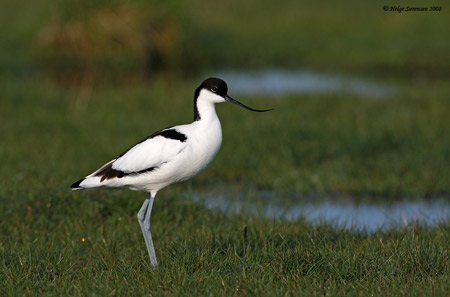
Avocet. Photo: Helge Sørensen
Stavns Fjord
Samsø, in the sea between Århus and Kalundborg
Large numbers of breeding and staging birds. Breeding cormorant, heron, greylag goose, shelduck, eider.
See Google map with look-out points etc.
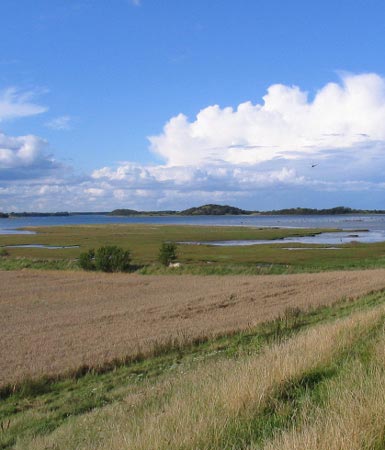
Stavns Fjord. Photo: Mogens Wedel-Heinen
Description:
Stavns Fjord is a large wetland covering around 20km2 on the east coast of Samsø. The fjord has several small islets and is bordered on the east by a narrow pebble spit, Besser Rev, which is over 5km long and Denmark’s longest pebble spit. To the west and south are coastal meadows. In some places, arable land reaches down to the fjord. North of the fjord are the peninsulas of Langør and Lilleøre, which have been formed by beach ridges.
Much of the water in the fjord is shallow but there is a deeper channel running into the fjord at Langør, west and south of the islet of Hjortholm, through the fjord opening and out into the Kattegat. Some of the fjord bed is exposed at low tide. The nine islets in the fjord are mostly covered in grass and scrub and are grazed by sheep and cattle. Scattered all over the fjord are many small islets and large boulders. This excellent habitat, with its nutrient-rich mudflats, lush meadows, and greatly varied landscape, offers ideal conditions for many breeding and migrating bird species.
Birds:
Breeding birds:
Denmark's largest cormorant colony, numbering around 2000 pairs, is spread over Yderste Holm and Kolderne in Stavns Fjord. There is also a grey heron colony of around 10-15 pairs on Karlskold, where there is also a rookery with around 30 pairs - the only one on Samsø. Greylag geese breed on the larger islets in the fjord, especially on Kyholm and on Lindholm east of the fjord.
Black guillemot nest on the islands east of Stavns Fjord, with Vejrø housing the largest population - 50 pairs. A few pairs breed on Lindholm and Kyholm. Kyholm also houses a number of non-breeding black guillemot every summer.
Stavns Fjord could for many years boast one of Denmark’s largest eider colonies with up to 2300 pairs (1973). But an outbreak of bird cholera, Pasteurella, in 1996 and 2000/2001 reduced their numbers to around 300 pairs. In 2007, a total count of the eider in Stavns Fjord was carried out, which showed that the population had increased fourfold, with 1200 nesting females. Today, the population is stable with around 1000 pairs.
Around 7-800 pairs of herring gull, 25-30 pairs of lesser black-backed gull and 30-40 pairs of great black-backed gull nest in Stavns Fjord and on the islets outside the fjord. Arctic tern breed regularly, with around 20-30 pairs, especially in years when Hjortholm, Mejlesholm and Yderste Holm are not plagued by foxes. 2-5 pairs of sandwich tern breed occasionally. Little tern has unfortunately stopped breeding in the area.
Avocets have had problems breeding on the islets in Stavns Fjord for several years due to fox predation, and the population reached a low of 2-3 pairs. However, thanks to an effective regulation of the fox population, 5-10 pairs have successfully established themselves on the southern side of Yderste Holm. In years when it has not been possible to regulate the foxes, there are no breeding terns or avocets.
Other breeding birdes include mute swan, shelduck, red-breasted merganser, oystercatcher, ringed plover, lapwing and redshank. The meadows around the fjord house many reed buntings, meadow pipits and skylarks.
Migrating and staging birds:
The first waders to reach Samsø in summer/autumn in any numbers are whimbrels, which stage on Nordby Hede and in the northern section of Stavns Fjørd in July and August. The first turnstones can be seen on Besser Rev in August.
In August/September more waders arrive from the north, especially golden plover and dunlin, with lesser numbers of curlew sandpiper, knot and grey plover. Many greenshank can be seen foraging in the shallow parts of the fjord, while turnstones prefer the pebble beaches on Besser Rev. In November, small flocks of the Icelandic race of redshank turn up and stay in the fjord all winter. Fair numbers of overwintering curlew are also seen. 75-100 turnstone and 30-40 purple sandpiper overwinter every year on Bosserne, south of Vejrø.
Teal, mallard and wigeon start arriving in large numbers in the first months of autumn. Goldeneye turn up at the beginning of October and stay for the winter. The many staging greylag geese and mallards are a prominent feature of Stavns Fjord in the winter months. Smaller flocks of wigeon stay here for the winter, too. More and more shelducks arrive in mid-winter. 150-200 dark-bellied brent geese can be seen in the fjord from October to May. The last few years, more and more barnacle geese have begun to stage in the fjord, and the last few years 4-5000 birds have been counted in the fjord and on the surrounding fields. Canada geese and white-fronted geese can also be seen, but in smaller numbers. Whooper swans are also prominent winter guests - around 200-300 every year.
In spring and winter small flocks of snow bunting and twite and a few rock pipits can be spotted foraging on Besser Rev.
At the end of winter, in February/March, the first ringed plover can be seen. In spring, predominantly golden plover, lapwing, oystercatcher and bar-tailed godwit can be seen in the fjord. The latter, especially, can be seen in quite large numbers foraging in all the areas of shallow water around the fjord together with, for example, greenshank and oystercatcher. This is also the period when the eider fly into the fjord from the Kattegat to breed round about on the islets. White-tailed eagle is seen regularly around the fjord, and peregrine can be spotted every winter.
Visiting and access:
Samsø can be reached by ferry either from Hov, south of Aarhus, to Sælvig on the west side of the island; or from Kalundborg on Zealand to Ballen Færgehavn on the east side of the island.
Public access is possible in a number of places along Stavns Fjord, with certain restrictions. Access is forbidden to all the islets in the fjord throughout the year, with the exception of Sværm, where it is permitted to walk on foot along the coast in the period 15th July – 31st March. It is also forbidden to go out onto Besser Rev and the coastal meadows on Hesselholm, Lilleholm and Barnekold in the period 1st April – 15th July.
Stavns Fjord can be viewed from several points, as there are many paths and farmtracks that lead down to the fjord. Some places have information boards. In addition, the following four sites can be recommended:
1. Langør on the northern side of Stavns Fjord. From the harbour, and especially from the Grønhøj hill next to the nature school, there is a good view across to the cormorant colony on Yderste Holm and to birdlife in general in the northern part of the fjord. The nature school also functions as an information centre. Here, there is an exhibition on nature in Stavns Fjord, including birdlife, and various leaflets describing the island’s nature and history are available.
2. Kanhave Kanal. From the outlet of this canal there is a view over to the islets of Egholm and Sværm.
3. Barnekold. From the embankment with an information board there are fine views across the southern part of Stavns Fjord towards Hjortholm, Karlskold and Eskeholm. Drive to the village of Besser, and turn left onto Smedegade from the main street. Turn left again onto Filipsdal, which is a gravel track. After around 1km park at the side of the road just before the first house on the right hand side. Follow the track on the left hand side for around 200m, and then right after a little copse of spruce trees, to reach the embankment.
4. From Besser Rev – and especially from the 10m high Hønsepold hill – there is a fantastic view of the birdlife out on the fjord.

Arctic tern with young. Photo: Mogens Wedel-Heinen
Sølsted Mose
South-west Jutland
Breeding cranes and passerines
See Google map with car parks etc.

Sølsted Mose. Photo: Jens Lyhne Christensen
Description:
Sølsted Mose is an old heath bog. It was formed when peat moss (sphagnum) began to grown on top of a layer of shifting sand that had covered the area many thousands of years previously. The moss was gradually decomposed and created peat. When the bog was drained and cultivated in the course of the 1900s it began to be invaded by willow and birch scrub. Parts of the bog were purchased in 1993 and 1996 by the Bird Protection Foundation, which now owns around 104 ha of the total of 180ha that form the bog. Between 2011 and 2016 an extensive project was carried out to ensure that the heath bog and the raised bog are recreated and secured. More than 50 ha of the scrub has now been cleared and the water level has been raised over a large expanse of the bog surface, while cattle graze the open areas. This means that the special heath bog plants can be protected and that conditions for the birdlife have improved. On the outskirts of the bog, buffer zones have been established. These are to be managed extensively, i.e. kept as permanent grassland without the use of pesticides or artificial fertilizers. At the same time, the Bird Protection Foundation has fenced in a large part of the area to keep in the grazing cattle.
Birds:
Breeding birds:
The open areas in the bog support typical birds such as bittern, snipe, water rail, whinchat, stonechat, red-backed shrike and grasshopper warbler. Sølsted Mose has one of Denmark's densest breeding populations of bluethroat, with 20-30 pairs. Marsh harrier also nests here, and in some years Montagu’s harrier. The rare willow tit and penduline tit breed in the bog. Another breeding bird is the crane, which reared its young in the bog for the first time in 2007, and is now present with 3-4 breeding pairs.
Migrating and staging birds:
In late summer, the air over the bog can be full of swallows hunting insects. Thousands of starlings roost in the reedbeds in spring and autumn.
Other animals:
Sølsted Mose is probably the only locality in Denmark where the rare air-breathing fish European weather loach (Misgurnus fossilis) breeds. The re-establishment project should also help to improve living conditions for this unusual species.
Visiting and access:
Sølsted Mose can be reached from the new car park on route 11 between Sølsted and Bredebro. From the car park, a boardwalk leads to a network of paths that can be used for walks of varying lengths.
It is also possible to drive in to the village of Sølsted and find Brændevej on its northern outskirts. At the end of Brændevej is a car park, from where paths lead out into the area.
There are information boards and leaflets at both car parks, and also picnic tables. On the walk round the bog, two bird hides offer good views.
It is a good idea to have solid footwear when walking round the bog, as especially in the winter months the paths can be muddy.
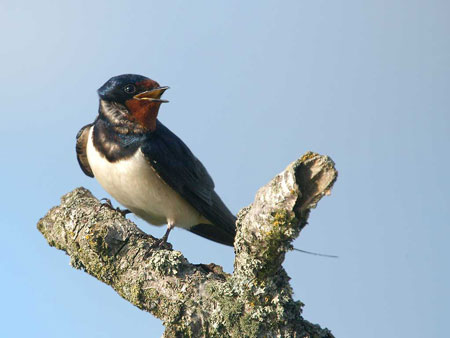
Swallow. Photo: Albert Steen-Hansen
Tinglev Mose
South Jutland, south of Tinglev
Breeding crane, marsh harrier, willow tit and bluethroat
See Google map with car parks etc.
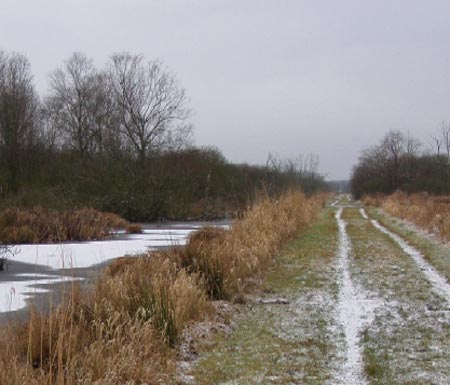
Tinglev Mose
Description:
Tinglev Mose was exploited for peat digging until the 1950s, but in 1967 the bog was drained to enable agricultural exploitation of the bordering areas. After the drainage scheme was completed, the area began to be overgrown, especially in the southern part. In 2003, a re-establishment project was begun. The water level was raised so that the birch scrub would disappear again. In the northern and eastern parts of the bog there are more open areas with reedbed.
Birds:
Breeding birds:
Tinglev Mose is a breeding site for many different bird species typical for reedbeds and bogs, even though they do not appear in large numbers. Little grebe, mute swan, greylag goose, mallard and coot nest around the lake. Most years a pair of cranes breed here, together with a pair of marsh harrier. Water rail also nest here, and snipe appear in good numbers. The reedbeds also attract sedge warblers, reed warblers and reed buntings. Penduline tit has been observed several times but it is uncertain whether it breeds here. In the scrub and the open areas there are thrush nightingale, bluethroat, whinchat, grasshopper warbler, marsh warbler, willow warbler, willow tit and red-backed shrike. Stonechat breeds regularly in the southern part of the area.
Migrating and staging birds:
Carrion crow and hooded crow can be seen foraging in the area all year round. Kingfisher is seen regularly along the canals. Lapwings stop over in the area during the migration period. Both spring and autumn, large flocks of starlings can be seen going to roost in the reedbeds; in autumn, especially, there can be very many birds, and flocks of over 100,000 birds have been recorded.
In winter, greylag goose, buzzard, hen harrier and kestrel are seen regularly. Dipper can often be spotted where the canal runs out of the bog, and now and again great grey shrike spends the winter here.
Visiting and access:
In the town of Tinglev, which is situated south-west of Åbenrå on route 42, there are signs leading to Tinglev Mose. Follow Mosevej to a car park, where there are picnic facilities. From here, continue on foot through the bog on a new trail, which leads to a tall observation tower with a good view across the bog. The tower has unfortunately become rather the worse for wear, so be careful when climbing up. To make a circular tour, turn south from the tower along Almstrup canal and back to Mosevej (see trail on the google map).
It is also possible to approach the bog from the south by following the signs from Bjerndrup or Bajstrup. The road between these two villages is Visgårdsvej. Keep an eye out for the sign to the bog. A little road turns off north here and ends at a car park near the bird observation tower.
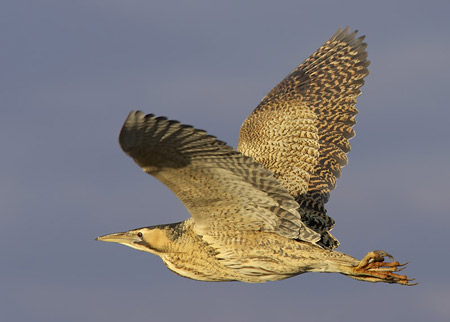
Bittern. Photo: Gerner Majlandt
The Tipper Peninsula
Southern end of Ringkøbing Fjord, west Jutland
Very important breeding and staging locality for ducks and waders. The Tipper Peninsula is one of Europe’s most important bird reserves.
See Google map with look-out points, bird observation towers, car parks, etc.

Værnengene. Photo: Joy Klein
Description:
The peninsula comprises three localites: the Tipperne nature reserve in the north, the meadows of Værnengene, and the dunes of Bjålum Klit in the south. Tipperne and Værnengene form a large, flat landscape covering around 3000ha with meadows, many ponds, canals and ditches. Large areas are covered with reedbed. The meadows are managed by cattle grazing, haymaking and by damming up drains and canals to keep back water during the birds’ breeding season. In the southern part of the area, Bjålum Klit rises up above the meadows. Here there are dunes, heath and bogland with some bushes. West of the Tipper Peninsula is the Nyminde stream.
The Tipperne nature reserve is state-owned. Bjålum Klit is privately owned but was put under preservation orders in 1974 together with the Nyminde stream. The whole fjord was put under preservation orders in 1985.
On Værnengene there is intensive hunting activity in the period September-December.
Birds:
Both during the migration period and the breeding season, the Tipper Peninsula can offer a very rich birdlife. The area is enormously important for the thousands of migrants that forage here on their way between Scandinavia and southern Europe or Africa.
Breeding birds:
Many of the species of duck and waders that stage on the peninsula spring and autumn also breed here, for example gadwall, pintail, garganey, shoveler, oystercatcher, avocet, lapwing, dunlin, ruff, black-tailed godwit and redshank. The Tipper Peninsula is one of the most important breeding areas in Denmark for ruff and the southern variety of dunlin (Calidris alpina schinzii). The area also supports breeding bittern, marsh harrier, water rail, curlew, arctic tern and yellow wagtail.
Migrating and staging birds:
Huge numbers of ducks stage on the fjord and the meadows during migration. The largest flocks are to be found in April and October, when migration reaches a peak. The most numerous species are wigeon, teal, mallard, pintail and shelduck, but there are also shovelers in the ponds and a lesser number of gadwall.
The area is also an important stop-over site for tens of thousands of waders, especially avocet, golden plover, lapwing, dunlin, snipe, bar-tailed godwit, redshank and greenshank. In addition, oystercatcher, ringed plover, grey plover, black-tailed godwit, curlew and various Calidris and Tringa waders can be seen. Now and again, rarer species can be spotted. The Tipper Peninsula is well known for the many ruffs that start arriving here from March and into May, when they perform their mating rituals on the lecks on the meadows. Most of the ruffs are migrants, but many stay on the meadows to breed.
In early spring, large numbers of geese can be seen, especially on the coastal meadows of Værnengene. Barnacle goose and pink-footed goose are the most numerous species, but greylag goose and dark-bellied brent goose can also be seen in fair numbers. In autumn, many thousands of pink-footed geese roost on the reserve.
Raptors that can be observed in the area include white-tailed eagle, buzzard, merlin and peregrine. Hen harrier forages over the reedbeds throughout the winter months.
In winter many geese, swans and raptors can be seen. From November to April, short-eared owls are seen regularly, especially in the area east of Store Mjøl.
Visiting and access:
From route 181, around 4-5km north-west of Nørre Nebel and just before Nymindegab, there is a minor road leading off north (signed Tipperne). From here it is about 5-6km to the Tipperne nature reserve. On the map shown below are suggestions as to where one can stop to look at birds. The numbers on the map correspond to the numbers in the text. (See also Google map).

1. Værnsande can be seen from two car parks on the road. From this road one can also reach Bjålum Klit which is a good place for a walk. By parking at Sydladen ('the South Barn'), which is the first car park to be reached, and walking around 50m northwards, one finds a track that leads all the way round Bjålum Klit (around 6km).
2. At Nordladen ('the North Barn') a bird observation tower has been installed inside the barn. There is also a nature exhibition, which is open day and night, and toilets, one of which is disabled-friendly. Outside, next to the car park, are a table and benches for visitors bringing refreshments.
3. The bird observation tower at Værnengene can be reached by turning right where the road meets a gravel road going north-south. At the end of the road is a group of pine trees where a new large observation tower was built in 2021. From here there is a fantastic view in all directions.
4. By turning north on the gravel road, the boundary of the nature reserve can be reached. The car park at the fence here is a good place to stop, especially in September/December. During this period, there are enormous flocks of birds on the reserve due to the hunting activities outside on the Værnengene. It is a good idea not to leave the car, so as not to disturb the birds.
5. The nature reserve is open as follows:
1st March - 31st July: Open Wednesdays and Saturdays from 9.30 h to 15.30 h.
1st August - 31st October: Open every day from 9.30 h to 15.30 h.
It is allowed to enter by car only. It is not permitted to get out of the car along the road. It is not permitted to walk or cycle because of disturbing the birdlife. The only place it is allowed to walk is on the grass surrounding the Tipperhus, the bird observation tower and on the marked path out to the bird hide. It is not allowed to bring dogs onto the reserve. The reserve is to be left before closing time.
6 & 7. There is also the possibility of parking on the road west of the Nyminde stream. There are two car parks on the coastal road between Nymindegab and Hvide Sande . The same birds as on the Tipper Peninsula can be seen here, but there is also a possibility of seeing grebes, diving ducks and mergansers.

Spoonbill. Photo: Axel Mortensen
Tøndermarsken
South Jutland, near the Wadden Sea just north of the German border
The area is one of the best bird localities in Denmark and is of great international value. Very large flocks of waders, ducks and geese stage here on migration. Several rare and threatened species breed on the marsh.
See Google map with look-out points, car parks, etc.
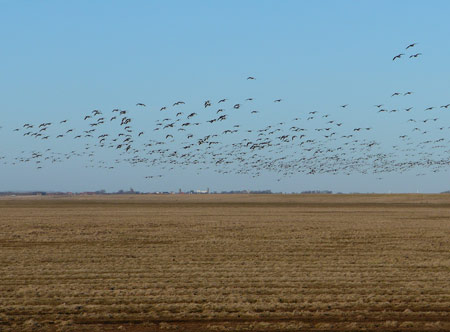
Tøndermarsken. Photo: Joy Klein
Tøndermarsken is the name given to 8 polders (kog = polder) - which are marsh areas enclosed by dykes - in south-west Jutland. The area stretches from the new seawall in the west (between Emmerlev Klev in the north and the German border in the south) and east to the road between Emmerlev and the German border at Sæd, south of Tønder.
The marsh is part of the flat landscape that stretches along the coast of the North Sea from Esbjerg and south to Den Helder in Holland. It is an old cultivated landscape marked by agriculture. In some areas, for example Tøndermarsken, cattle and sheep graze the land, whilst other areas are intensively cultivated with grain and other crops. There are lakes, rivers, reedbeds and meadows. 300km of canals and ditches cut through the marshes. On the state-owned areas in the northern section of Gammel Frederikskog a new management has begun to help meadow-breeding birds, and has proved to be a success. The state has now purchased further sections of the Kog.
Breeding birds:
Tøndermarsken is still one of Denmark’s richest bird localities despite a noticeable fall in the number of breeding birds, especially meadow birds.
Magisterkog (east of Rudbøl and just north of the German border) is home to breeding bittern, greylag goose, gadwall, marsh harrier, spotted crake, black tern and all the common birds found in such a habitat. Savi’s warbler also breeds here. Magisterkog is one of only three localities in Denmark where it breeds regularly. This area - especially along the north side of Magisterkog - houses Denmark's largest population of bluethroat.
To the west, towards the sea, the landscape hosts breeding shoveler, gadwall, garganey, lapwing, black-tailed godwit, redshank and yellow wagtail.
Migrating and staging birds:
The area is well known for the many waterbirds that collect here. Geese arrive in their thousands, including barnacle geese, pink-footed geese, greylag geese and white-fronted geese. All the species of duck and wader that can be found in Denmark can be seen in the locality in the course of the year, when they are migrating or staging.
Raptors that visit the area regularly include peregrine, merlin, rough-legged buzzard, hen harrier and white-tailed eagle, while large flocks of passerines such as thrushes, pipits, wagtails, larks, hirundines and finches visit the area.
A spectacular phenomenon that can be experienced here in the spring and especially in autumn is the so-called ‘Black Sun’ (‘Sort Sol’ in Danish) when enormous flocks of starlings fly in fantastic formations over the meadows before going to roost for the night in the reedbeds.
In winter, flocks of up to 2000 whooper swan and Bewick’s swan can be seen. They often congregate on Bremsbøl Sø and/or Nørresø for the night. Northern species such as shore lark, snow bunting, twite and lapland bunting can also be spotted.
As already mentioned, the area described here stretches east of Margrethe Kog between Emmerlev in the north and the German border to the south. The road between Emmerlev and Tønder (route 419) and the road between Tønder and Sæd (route 11) form the eastern border of the area. It is a good idea to bring one’s passport, as it may be tempting to cross the border into Germany.
To reach the lake of Bremsbøl Sø, drive south at the roundabout just east of Tønder and turn west to Bremsbøl just before reaching the German border. The Bremsbølvej road leads to the lake. After around 1½km, the Bird Protection Fund's car park can be seen on the left. Here is a picnic spot, and a path leading to the bird hide, from where there is a fine view over the lake.
About 1km further along the Bremsbølvej, just after the railway crossing, one can join the Marsh Trail which leads south and then west behind the dyke on the north side of the Sønderå stream. Here there is an outlook point and, further along, a hide with a view over the Danish section of the Hasberg Sø. The hide can also be reached by parking at Møllehus at the border and walking along the dyke on the north side of the Sonderå stream (there are signposts). The walk is around 1.5-2km long. Alternatively, Hasberg Sø can be reached by parking at one of the two car parks along the Grellsbülldeich road on the German side of the border just west of the lake.
Velling Skov and Vrads Sande
West of Salten Langsø and Mossø, in the middle of Jutland
Coniferous and deciduous woodland with bogs and lakes and breeding woodland birds.
Typical heathland-breeding birds at Vrads Sande.
See Google map with look-out points, car parks etc.
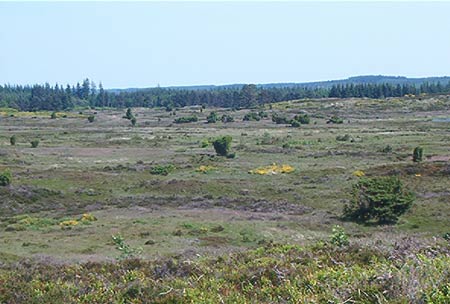
Velling Skov and Snabegård Plantage form a continuous wood covering around 500ha, connecting the large plantations in the west with the woods around the lake of Salten Langsø in the east. Velling Skov has Denmark’s largest stand of 250-300 year old beech trees and is a more or less “untouched” natural wood. The last few years, quite a few of the old giants have started to topple or crack due to storms, but it is intended to leave the dead trees and trees that have fallen over where they are, thereby creating a basis for a rich animal and plant life in the wood. The wood is situated on the slopes of the Salten Å valley, facing north. The ground is steep and there are many springs. Snabegård Plantage is immediately west of Velling Skov. It consists of conifer trees and was planted at the beginning of the 19th century.
Vrads Sande is a very hilly heath area between Vrads and Hjøllund, formed by shifting sand between the 16th and 19th centuries. The area covers 1.5km2 and was put under preservation orders in 1968. It forms a large basin with a small lake in the middle. The hollow is sprinkled with small sand dunes that are now covered with vegetation, and the remains of terraces formed by meltwater in the ice age. The area is fenced in and grazed by cattle in the summer months.
Breeding birds:
All the common forest birds can be found in the woodland. Amongst the most interesting species are a good population of stock dove, black woodpecker, green woodpecker, wood warbler and firecrest. Pied flycatcher has unfortunately disappeared completely. Honey buzzard, buzzard, red kite and goshawk breed in the woodland, which also houses eagle owl and several pairs of breeding ravens.
The two woods lie around 15km south of Silkeborg and 26km west of Skanderborg. The main 453 road between Nørre Snede and Them passes through the town of Bryrup. By driving north out of Bryrup, through Velling, one reaches Velling Skov, where there are two large car parks (with toilets and picnic facilities) on both sides of the road just before a sharp bend. One can also turn left towards Vrads at the roundabout in the middle of Velling and continue around 2½km to a car park between Snabegård Plantage and Velling Skov (south of the Nature School). There are many paths through the woods and it is recommended to use the Nature Agency’s leaflet about the area, which can be downloaded here.
To reach Vrads Sande, one can continue from the car park just mentioned to the town of Vrads. From here, drive north-west towards Hjøllund. Along the road between Vrads and Hjøllund, which winds through the area, are several excellent, small lay-bys. From one of these in the most north-westerly corner of Vrads Sande one can climb up to a ridge west of the road, from where there is a very fine view over the area. There are no proper paths in Vrads Sande, but one can walk over the grass and heather around the whole area.
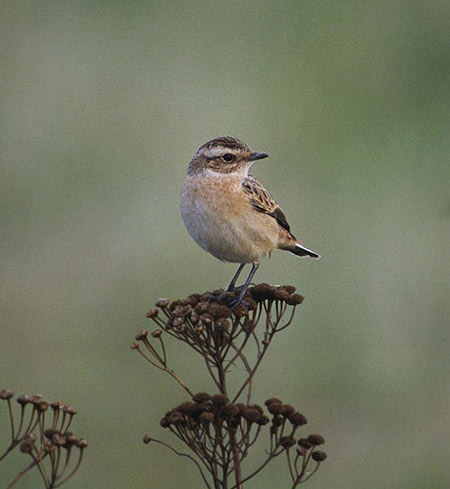
Whinchat. Photo: Albert Steen-Hansen
Vænge Sø
Helgenæs, Djursland, east Jutland
A re-established lake with breeding and staging water birds and a cormorant colony. See google map for car park etc.
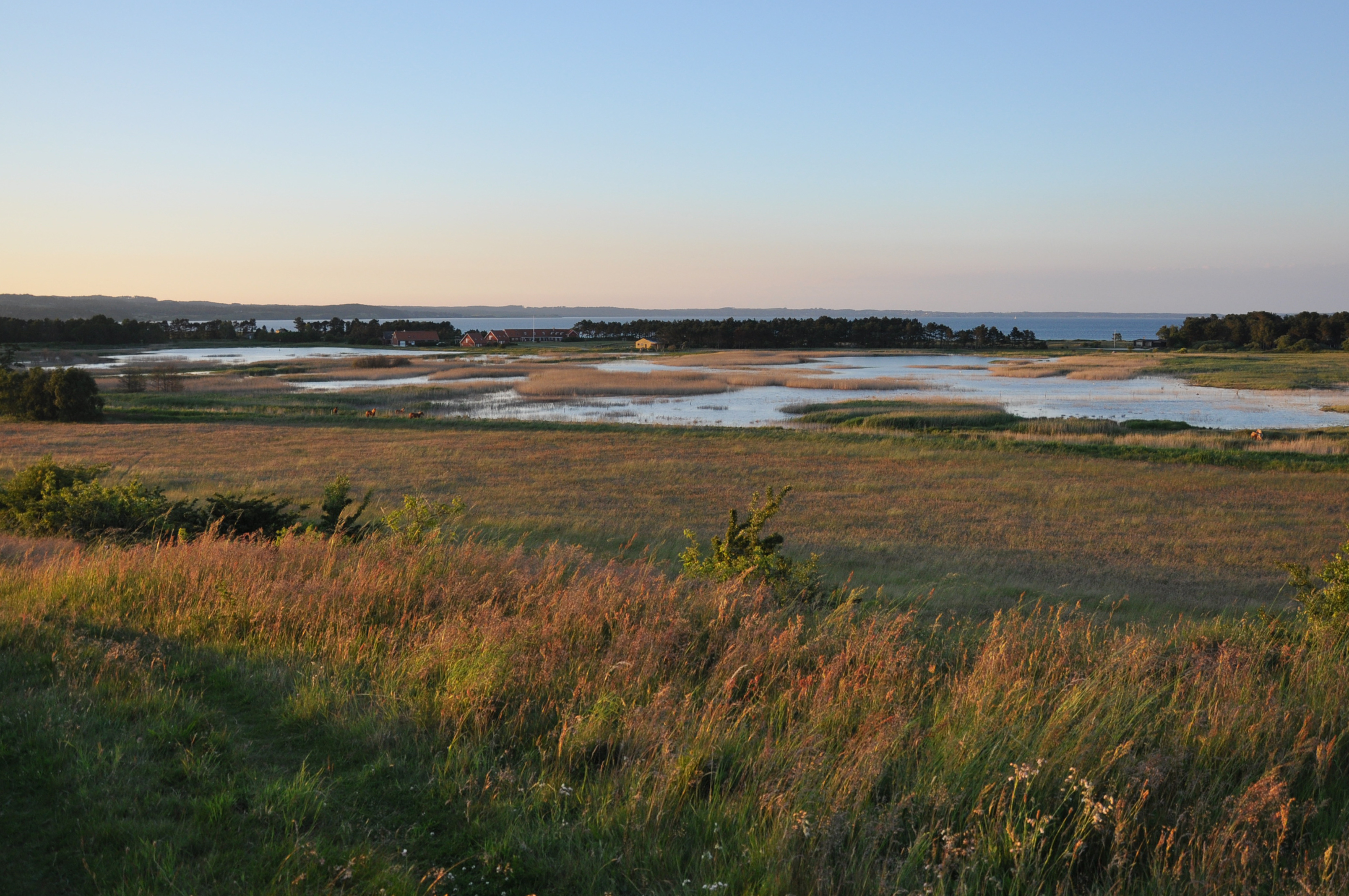
Vænge Sø. Photo: Joy Klein
Description:
Vænge Sø was originally a shallow lake that probably originated as a lagoon that in time was cut off from the bay of Ebeltoft Vig. The lake was drained in the mid-1800’s and used as grazing land for cattle and for haymaking, but the area was gradually taken over by reedbeds. In 1943 a new draining project opened the way for growing cereals and beet. However, draining became more and more difficult and in 1993 the state purchased the 35 ha area to re-establish the lake. The project was realized in 2013. As there are now school buildings between the original lake and the sea, it was impossible to create a lake covering the original area, so that a smaller lake of 26 ha was the best alternative. The water level in the lake is regulated by a pump.
The state’s area covers the lake itself, a grass meadow and a hill with dry grassland in the south-western section. The lake is surrounded by reedbeds. It was originally intended that the vegetation round the lake and the meadow were to be grazed by cattle, but these plans have been dropped for the time being. The meadow is used for hay and the small islets of reeds in the lake have gradually disappeared due to a rising water level. The dry grassland is grazed by horses.
Birds:
Breeding birds:
In the breeding season characteristic sounds at the lake are the squeals from the many red-necked grebes, the trills of the little grebe and the grunting of the many cormorants in their colony at the southern end of the lake. The colony was established in 2016 with 15 nests and has since grown to around 370 nesting pairs. Red-throated grebe are numerous, often with over 30 individuals, many of them breeding. Little grebe is also common, with several breeding pairs. In addition, mute swan, greylag goose, water rail and coot are among the most common breeders. Mallard and tufted duck breed sporadically. The reedbeds house many marsh warblers, reed warblers and reed buntings. Bearded tits are present throughout the year and have been seen with young on several occasions. The grasslands are home to several species of passerine and now and again red-backed shrike.
Migrating and staging birds:
The lake is used as a staging post for large numbers of birds. Greylag goose can be seen in large flocks and tufted duck can be seen throughout the year, with the largest numbers in winter. In addition, widgeon, gadwall, teal, mallard, shoveler, pochard and goldeneye are seen.
Only few areas around the lake are suitable for waders. Lapwing is the commonest wader to be seen but there are also fair numbers of snipe. Other waders have formerly included curlew sandpiper, dunlin, ruff, spotted redshank, redshank, greenshank, green sandpiper, wood sandpiper and common sandpiper, but due to the higher water level they are now seldom seen.
Starlings sometimes use the reedbeds as an overnight roost, and all three hirundine species can be spotted foraging over the lake – of these, sand martins nest at the shore nearby.
Raptors include white-tailed eagle, which can now be spotted all year round, buzzard and kestrel and – in summer – marsh harrier.
Rare birds spotted at the lake include red-necked phalarope (2018, 2020 and 2021 - always in August) and great reed warbler (2015, 2016 and 2017). Bluethroat was seen in spring 2020 but it is uncertain if it bred here. Spoonbill has been spotted in 2022 and 2023.
Other animals:
In the breeding season edible frog are abundant.
Visiting and access:
The lake can be reached via Dragsmur, which is the narrow isthmus between the peninsula of Helgenæs and the rest of Djursland. Turn left along Olaf Ryes Vej in the direction of Esby and after around 1½ km the entrance to the car park at the lake is reached. Here is a picnic bench but the area around it is sometimes unfortunately rather wet. There is access to the embankment which runs along the western side of the lake, although it may be difficult to walk along sometimes, as the vegetation is only cut occasionally. Rubber boots are always advisable. A little distance north of the car park is another picnic bench with a view across the middle section of the lake. It is also possible to walk the whole way along the embankment to the north and out to the bay of Ebeltoft Vig, where there can be seabirds.
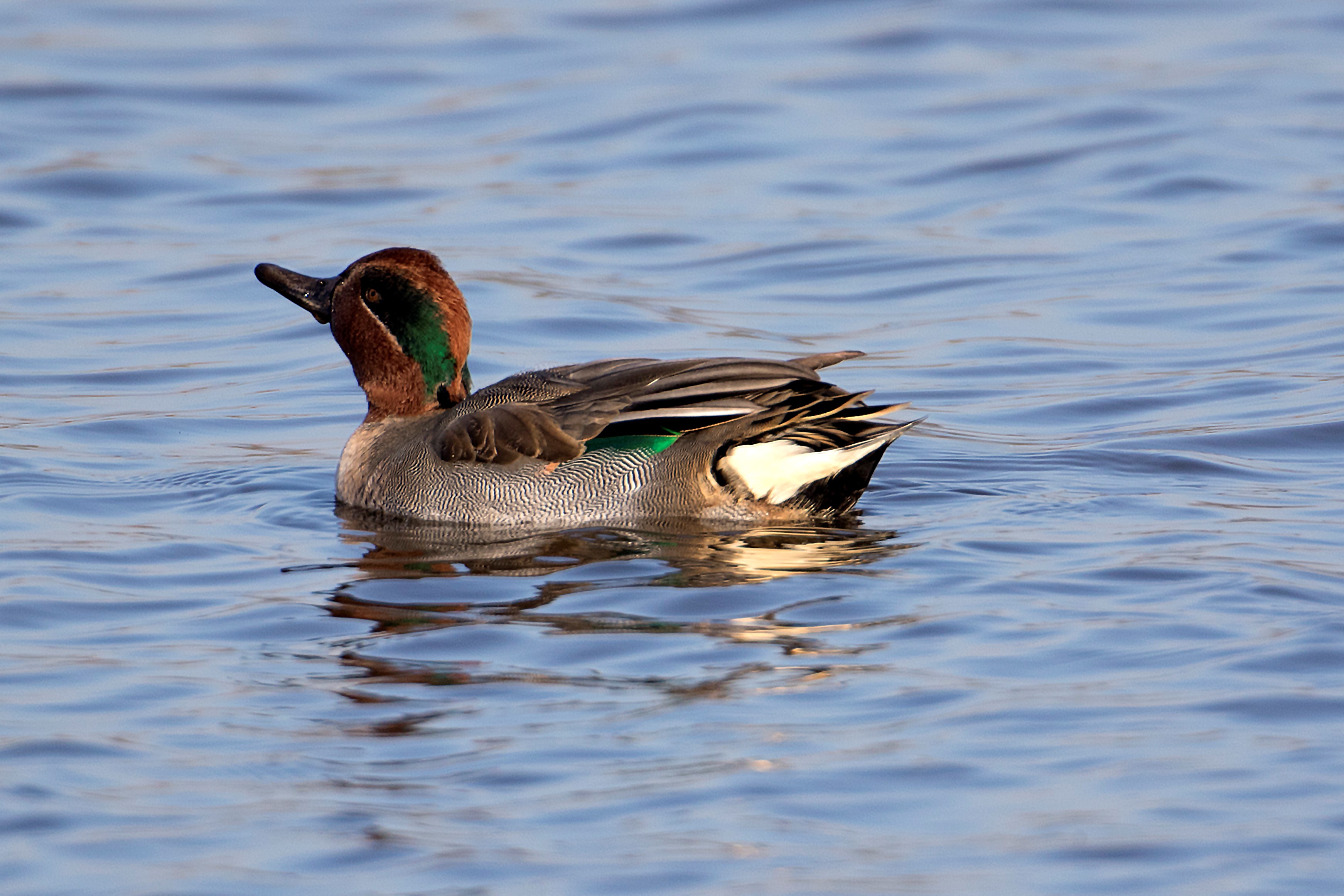
Teal. Photo: Keld Christensen



